42 SEO tasks you can complete in SE Ranking today
Whenever SEO experts are asked what they do for a living, most of the time the answer you hear is: “I optimize websites so they rank higher in search engines like Google.”
But what about optimizing the workflow to do more and do it better? The name of the game for SEO professionals today is to automate every possible thing because time is money. And our all-in-one SEO platform called SE Ranking is perfect for this.
We did the math, and it turns out that you can get over 40 key SEO tasks done using only SE Ranking’s tools. But that’s not even the limit. I’m sure you can find more ways of using our platform to maximize your SEO efforts.
Now, let’s go through the main SEO tasks that can be done with the help of SE Ranking.
Keyword Research
1. Collect keywords for organic promotion
Creating a keyword list and expanding it requires finding the right search terms.
SE Ranking’s Keyword Research tool makes this process easy. Just enter a keyword or phrase along with the country, and then go to the Keyword Suggestions section. This section provides a list of keywords that are similar and/or related to the analyzed keyword. In the table, you will see all essential keyword metrics, including:
- Ranking difficulty for a specific keyword
- Search volume
- Search intent
- SERP features displayed for the analyzed keyword
To better understand how SE Ranking’s Keyword Research generates accurate numbers, read our blog post about the algorithms behind it.
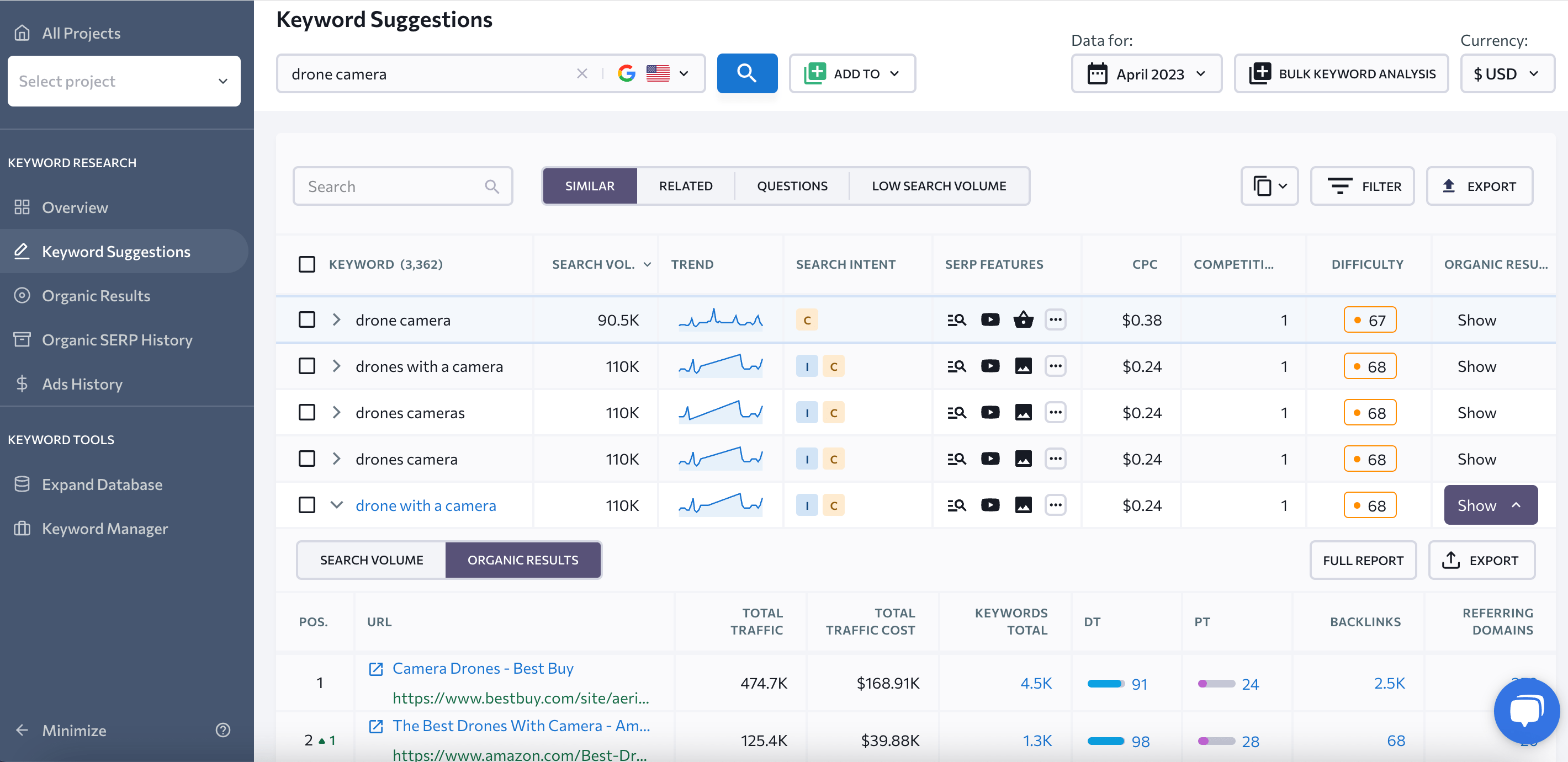
To select effective keywords, focus on keywords with high search volume, meaning keywords that many people are searching for. Take keyword difficulty into account to find not-so-complicated terms to rank high for.
You can then export the list you create in XLS or CSV file formats.
2. Expand semantics with search engine suggestions and long-tail keywords
Keep search engine suggestions in mind when collecting keywords. Search suggestions are popular search terms that start with the same letters as your query and appear in the expanded menu as you type in the search box.
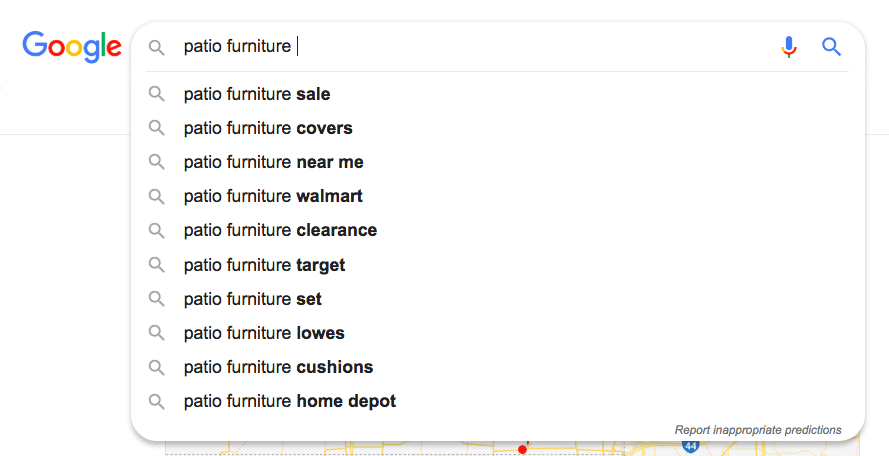
SE Ranking lets you export a list of search suggestions for any keyword. Just go to the Keyword Research tool, and in the Low Search Volume and Questions tab of the Keyword Suggestions section, you’ll find plenty of search queries.
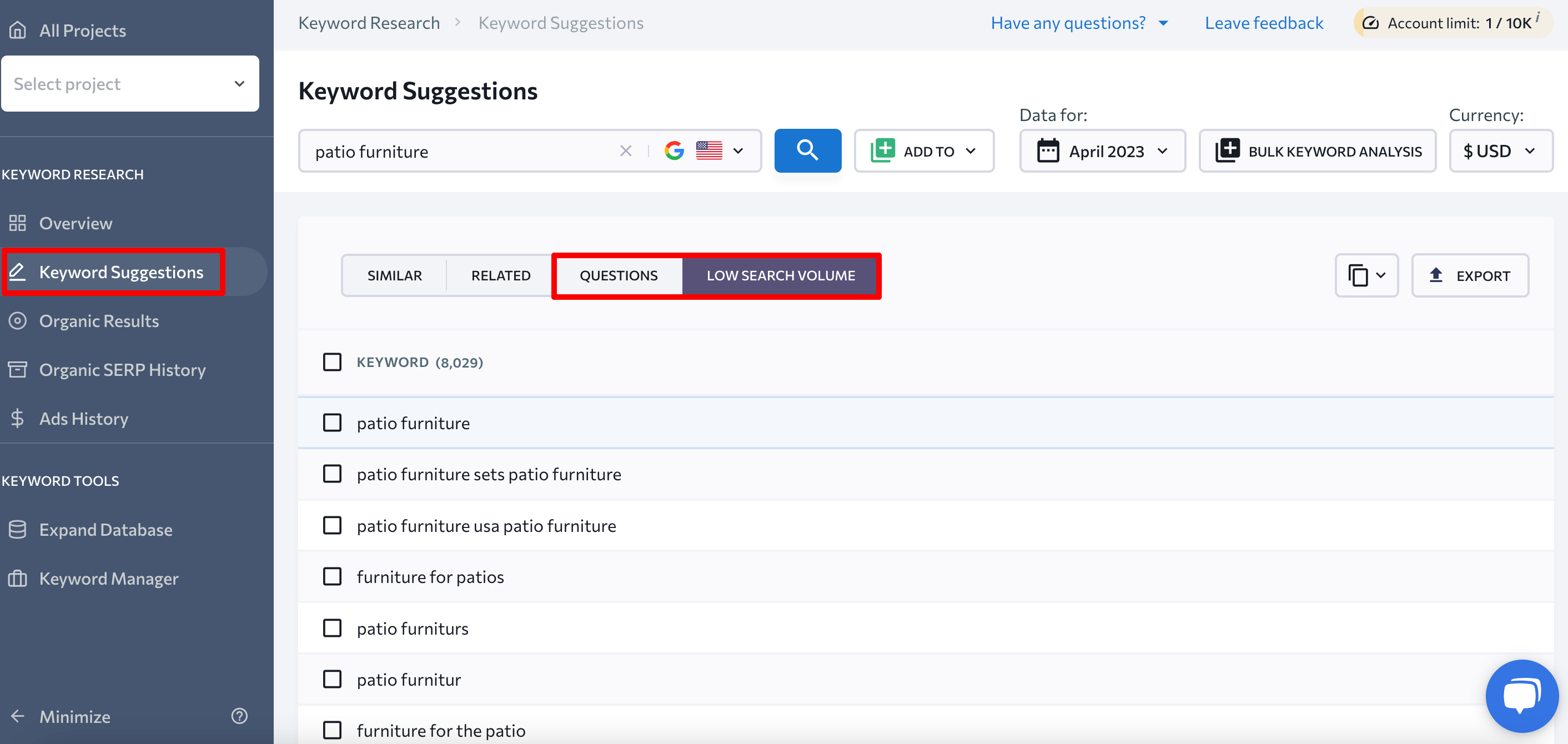
Question-based and long-tail keywords aren’t searched for as often as other keywords but they typically have a clearer search intent.
3. Find competitor keywords
As a rule of thumb, relevant keywords that are already popular and effective in your niche are used by your competition. Being a vital source of keywords, it is strongly advised that you research your competitors as you’re putting your keyword list together.
Finding competitor keywords in SE Ranking is easy as entering a competitor’s domain into the Competitor Research tool’s search box and hitting Enter. In the Organic Traffic Research section, you will then see a list of organic search queries that your competitors already rank for in the SERPs.
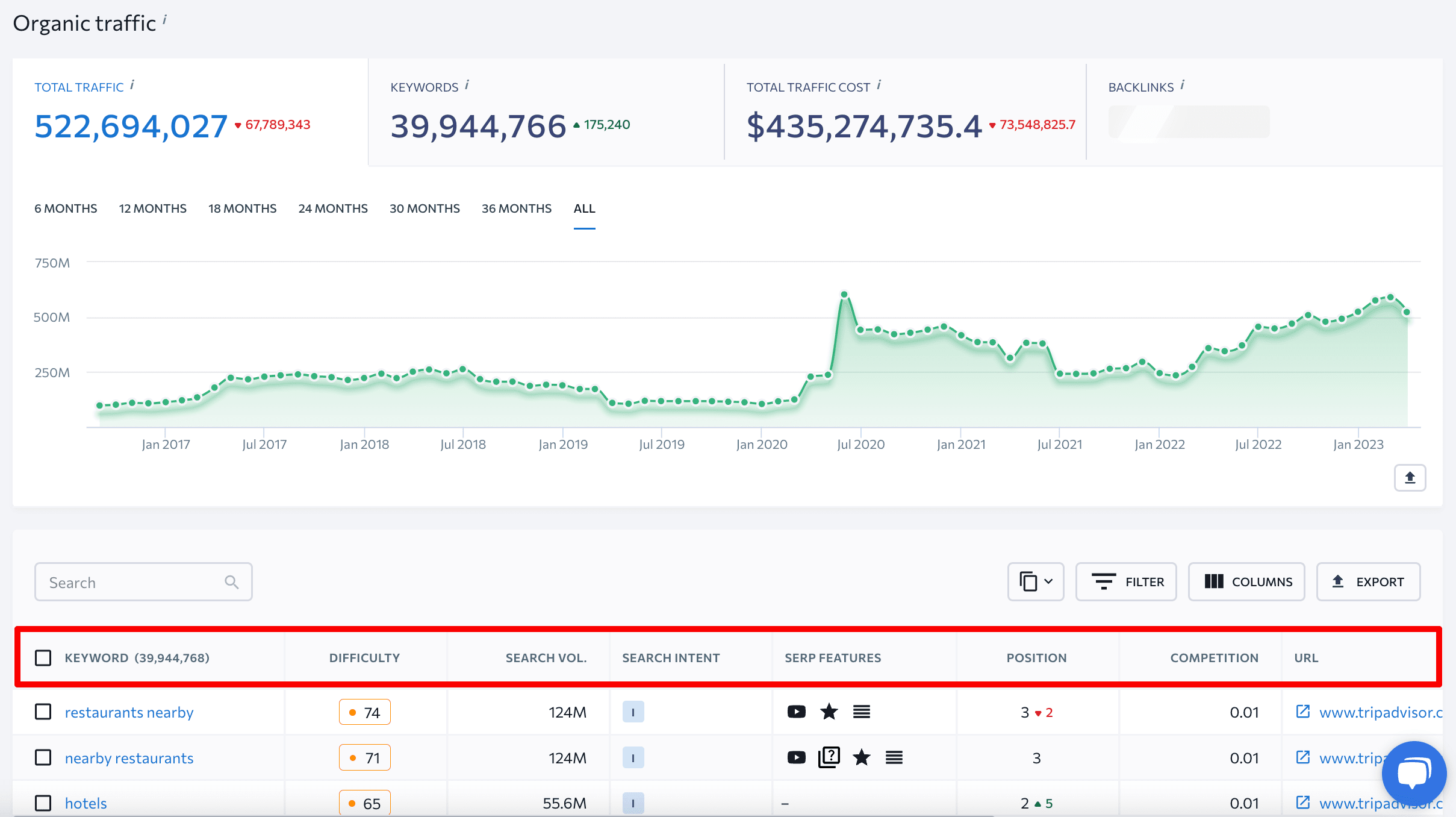
4. Analyze keywords in bulk
You have the option to run a bulk keyword analysis. This means that you can get key parameters for multiple keywords at a time.
To access the Bulk Keyword Analysis feature, go to the starting page of the Keyword Research tool.
To start analyzing a list of keywords, first, select a country from the available options. Then, you can either manually enter keywords one by one into the provided field, or import them using a TXT or CSV file.
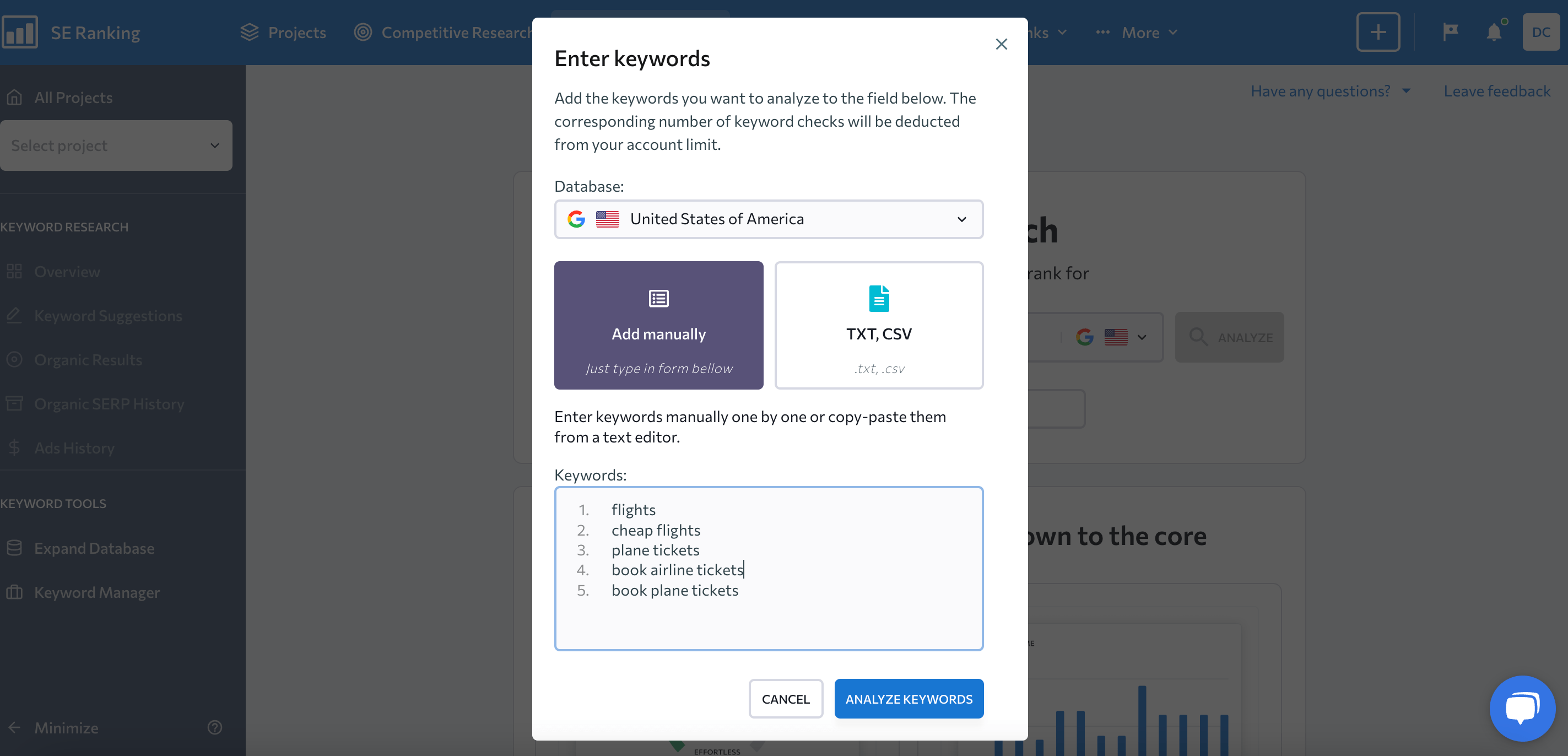
5. Let us add your target keywords to SE Ranking databases
If you work at a niche business that promotes pages using long-tail keywords with a low monthly search volume, you probably have a hard time getting data for your keyword list. And since there aren’t any SEO analytics services that have every imaginable keyword in their database yet, you don’t have that many options.
Because we want everyone to have the possibility to get the necessary keyword data, we’ve added a useful new feature called Expand database in our Keyword Research tool. With this feature, you can upload your own keywords to our country databases and get a detailed SERP analysis on each one, organic and paid results included.
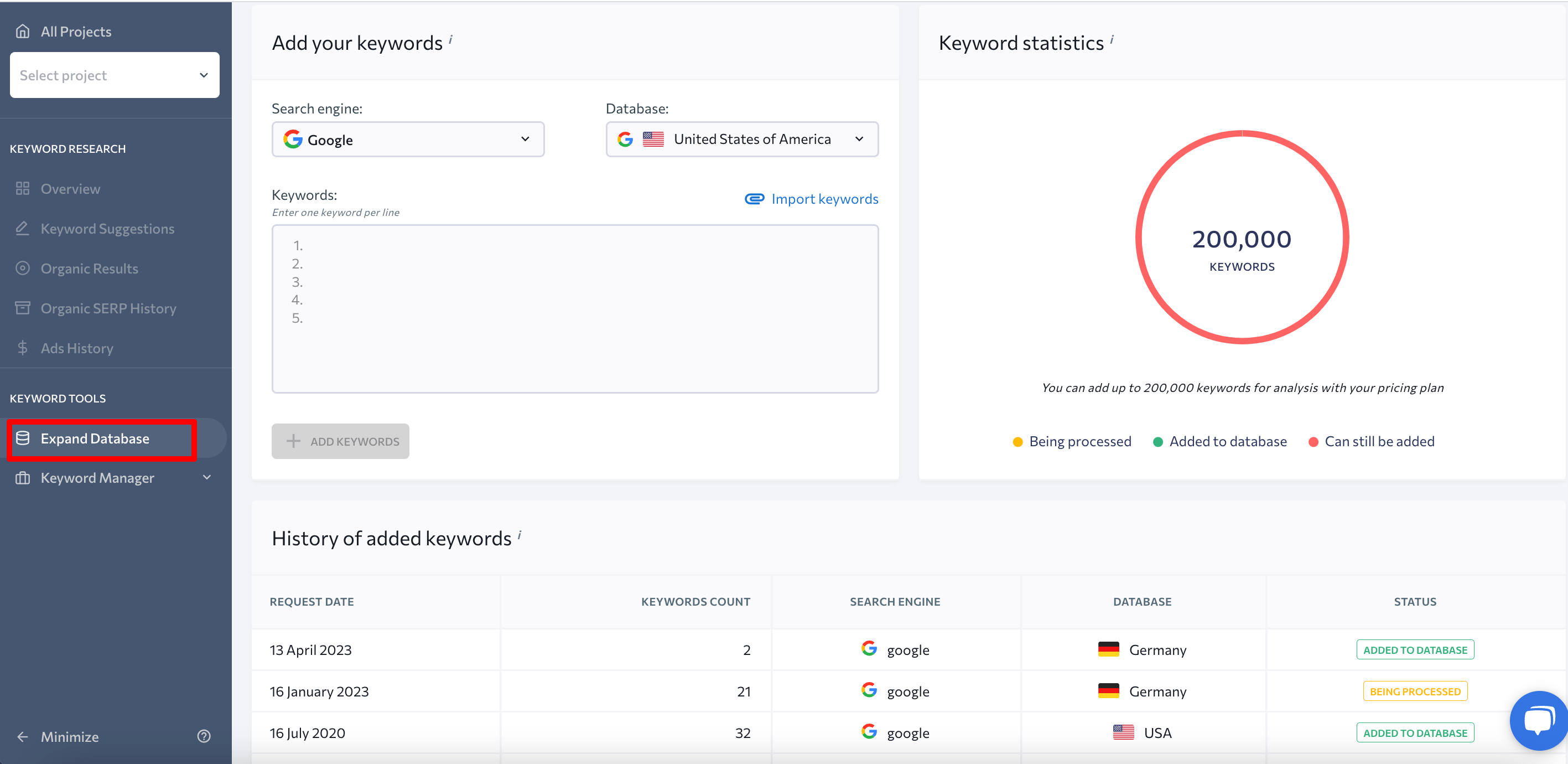
You can get more details on the new features in our Help Center.
6. Check the SERP history of the most promising keywords
Monitoring SERP fluctuations is essential to an effective SEO strategy as it allows you to stay up-to-date with the latest trends in search engine rankings and optimize your website’s visibility. By keeping track of competitors’ websites and their movements up or down in the search engine rankings, you can assess your potential to outperform those pages. To access this info, go to the Organic SERP History section within the Keyword Research tool.
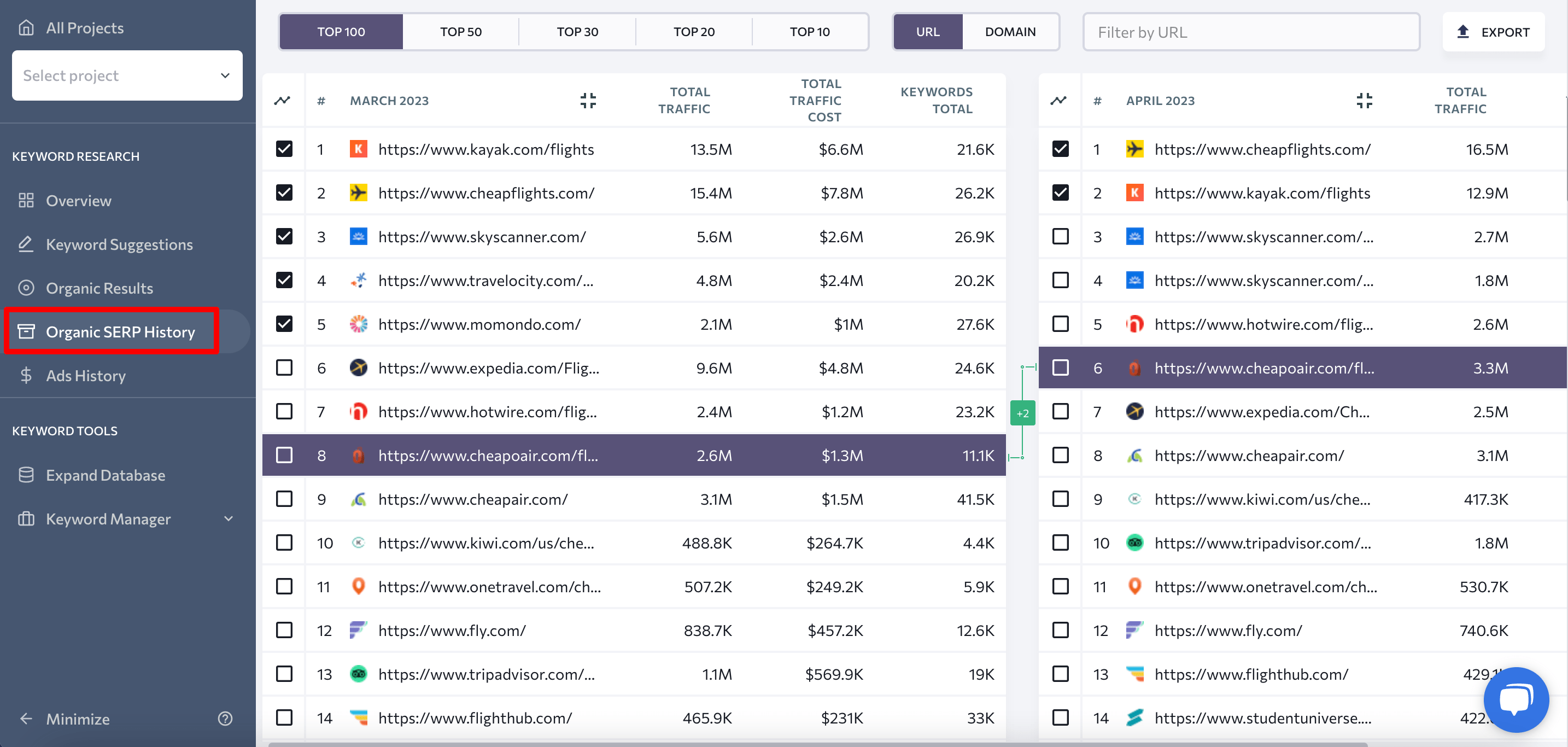
Here, you can explore a table that displays the top-ranking pages and track any changes in their positions. If they aren’t changing much and you don’t see any new top players, this indicates that it will be difficult to make it into the top 10. The more stable the SERP is, the harder it will be to outperform top-ranking pages.
7. Collect keywords for your PPC campaigns
Running PPC campaigns requires relevant keywords that align with your business and target audience. By targeting the right keywords, you can maximize the effectiveness of your advertising budget and drive qualified traffic to your website. SE Ranking offers valuable PPC-specific insights in addition to its equally essential search volume metric.
One important parameter for assessing keyword potential in PPC is the level of competition. In SE Ranking’s Keyword Research, it is expressed in percentages and is based on Google Ads data. The higher the number, the steeper the competition.
CPC (Cost per click) is another metric that is crucial to the success of PPC advertising because it helps determine how much advertisers will pay for each click on their ad.
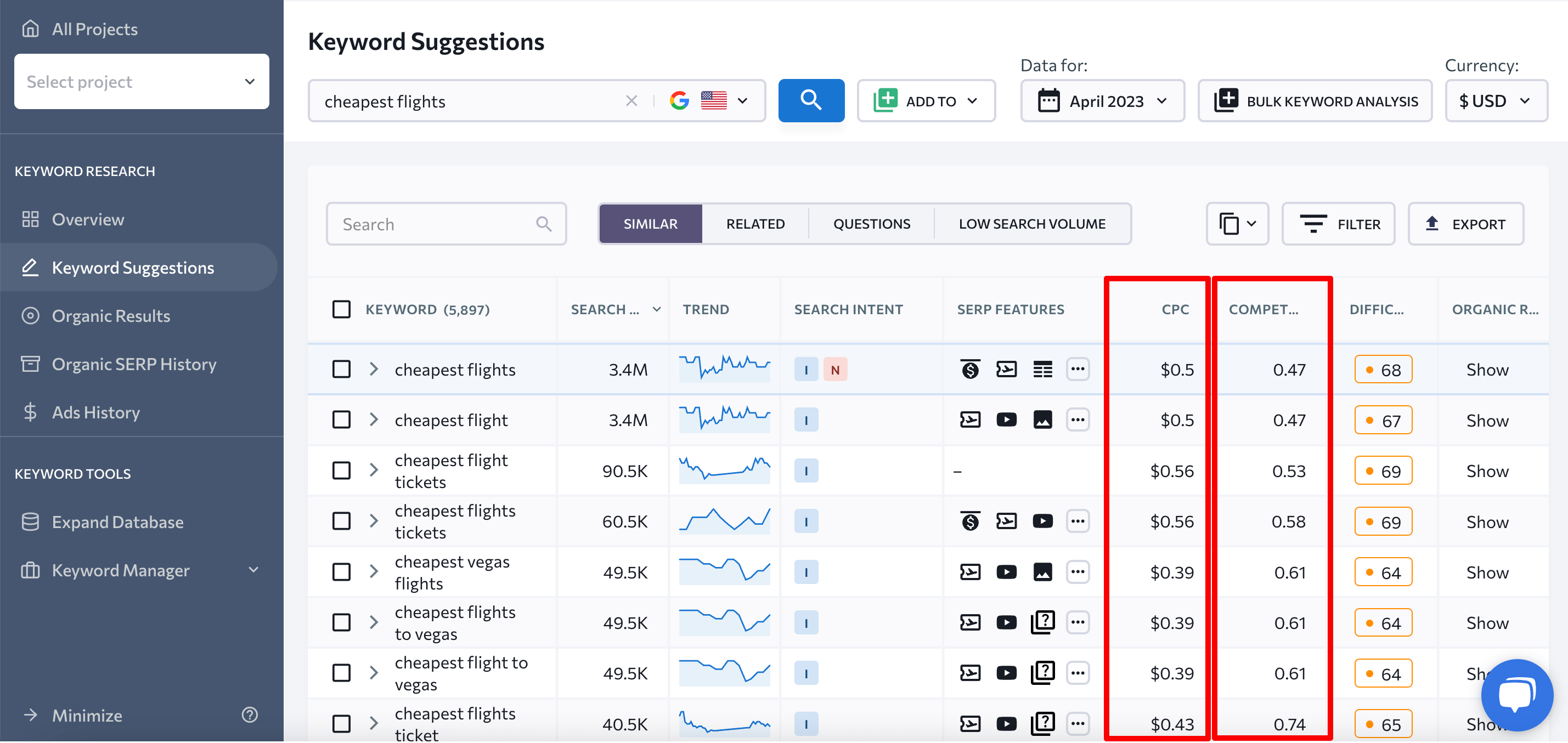
To collect valuable keywords and discover successful ideas for your ads, you can go through monthly ads history in the Competitive Research tool. Enter the competitor’s website and go to the appropriate section to discover which ads work best for your competitor and build better ones for your campaign.
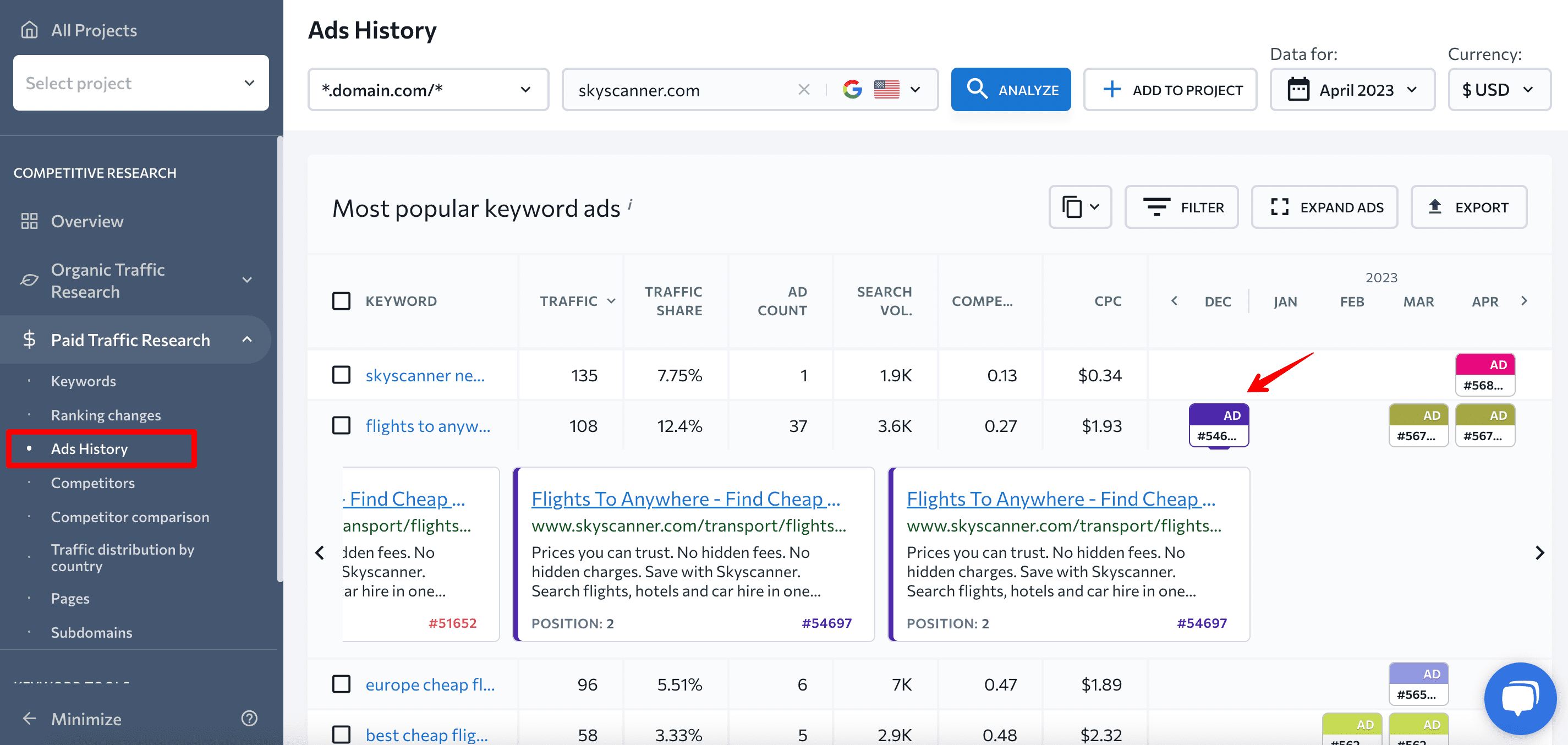
8. Save keywords to the Keyword Manager
You should save any promising keywords found so you can use them in future SEO and PPC campaigns. Keyword Manager can help you do this, as it allows you to manage different keywords that you added either manually or from Keyword and Competitive Research. With the help of Keyword Manager, you can create, update, and save keyword lists for different regions in one place. It even helps you keep an eye on fluctuating keyword metrics and search results.
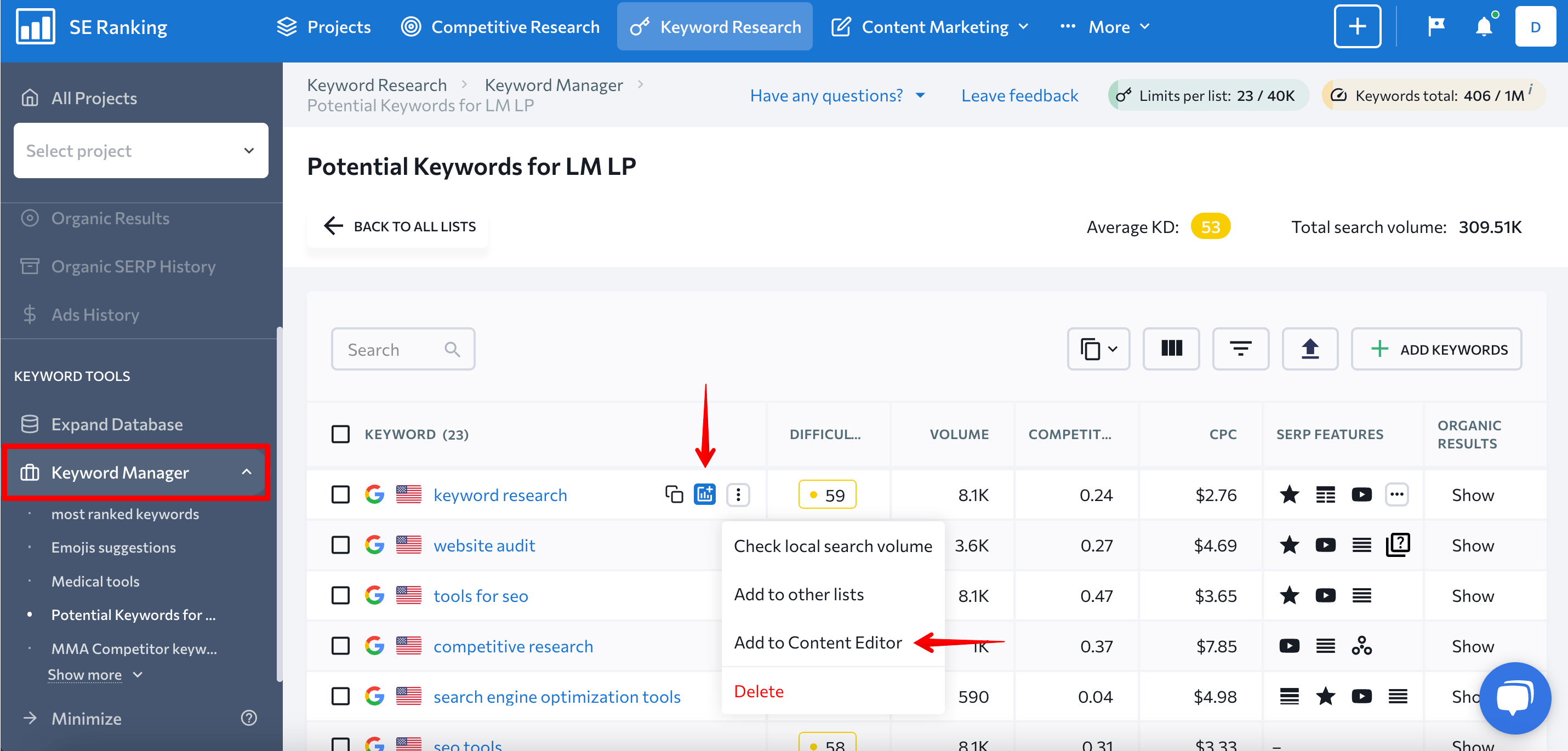
This tool enables you to seamlessly integrate the keywords you’ve added into other SE Ranking tools for enhanced functionality. For instance, you can immediately add them to any of the articles that are in the Content Editor. You can also include these keywords in the Rank Tracker tool, which allows you to monitor your website positions on Google, Bing, and Yahoo.
9. Group collected keywords
Now that you’ve created a list of keywords using our Keyword Suggestions feature and expanded it further with your competitors’ keywords, you have a solid keyword list you can put to use. The next step is to bucket your keywords into groups. These keyword groups can then be spread out among different web pages and used in the website’s SEO structure planning as well.
With the Keyword Grouper tool, this task can be completed in a matter of minutes. Select the country, region, Google interface language, plus define the keyword grouping accuracy (minimum number of matching URLs) and the automatic grouping method (Soft or Hard). The higher the grouping accuracy, the fewer keywords will be put into the same group. Ultimately, you get a grouped list of keywords along with their search volume data.
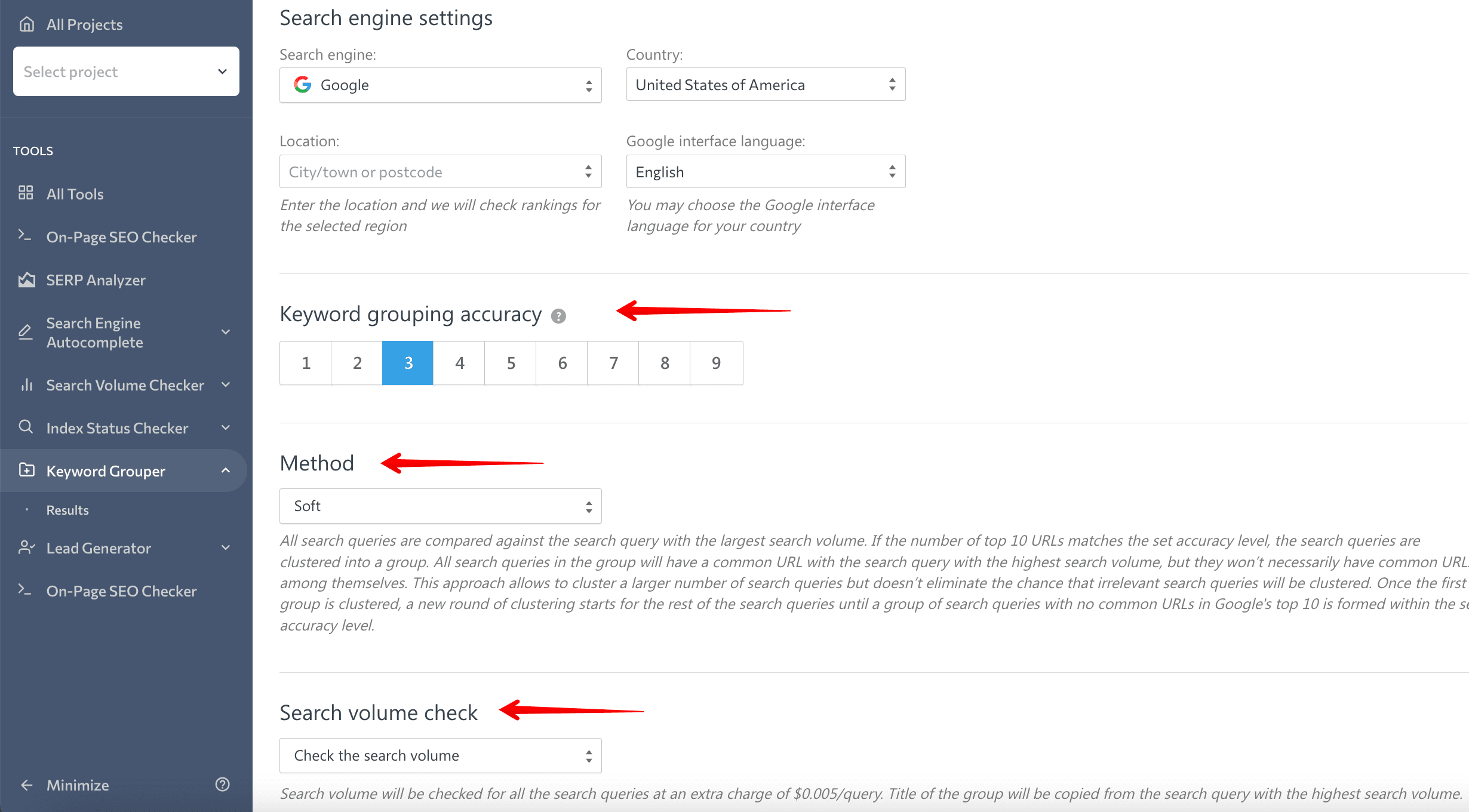
Content creation
10. Find new topic ideas
Content creation is an essential element of website optimization. If you’re involved in SEO, you’re likely familiar with the challenges of finding efficient article topics. That’s where Content Idea Finder comes in. It serves as your go-to assistant for coming up with relevant and interesting topic ideas. It analyzes a keyword closely associated with your desired topic and creates a cluster of relevant keywords for your new article. You can also see the titles of pages ranking in the top 10 search results for the keyword with the highest search volume in the cluster. Simply enter the keyword closely related to your website’s topic, business category, or the article you want to write. After selecting a country and region, click Find ideas.
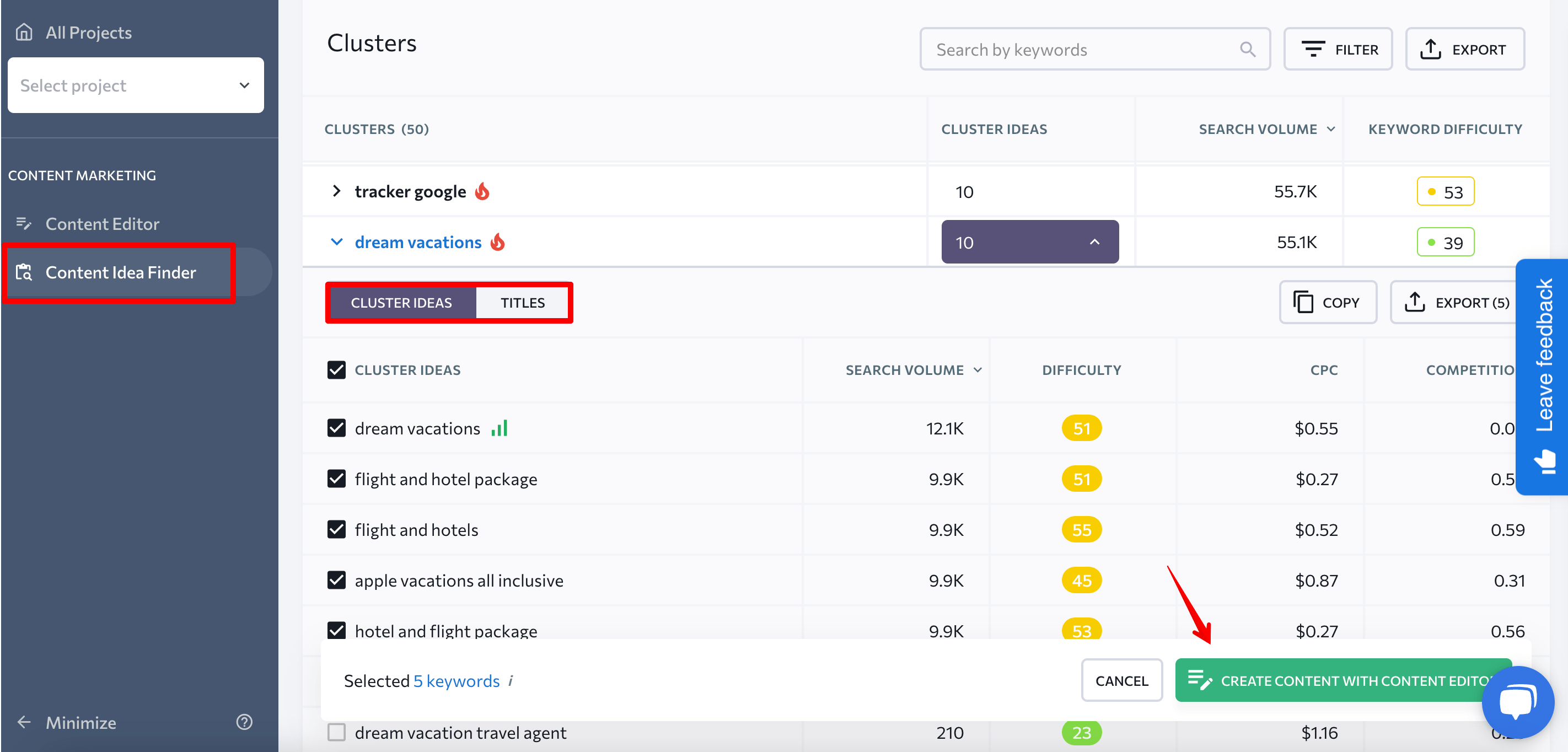
Keywords in SE Ranking come with comprehensive SEO and PPC data. You can compare them by difficulty and search volume. With just one click, you can export them to Content Editor and start creating a new article. Choose up to five keywords, then click the Create content with Content Editor button.
11. Create a brief
Once you have identified content ideas, you can create a brief that outlines the expectations and key messages for the content. To complete the brief, use the Content Editor tool, which analyzes top-ranking competitive content and builds SEO briefs based on this analysis. Here are the sections you will find in the brief:
- Content parameters. This section determines your new article’s recommended number of words, headings, paragraphs, and images.
- Terms to use. With the help of NLP, you will get a list of needed terms for creating compelling content.
- Content structure. This section provides you with headings from your competitors’ pages. You can use them as sources of inspiration for your article.
- Links. In this section, you can add the external and internal links that you want to use in the article.
- Questions. This section enables you to add questions to the article from Google’s People Also Ask section or from competitor websites.
- Metadata. This section lets you set recommendations for the title, description and slug in the brief.
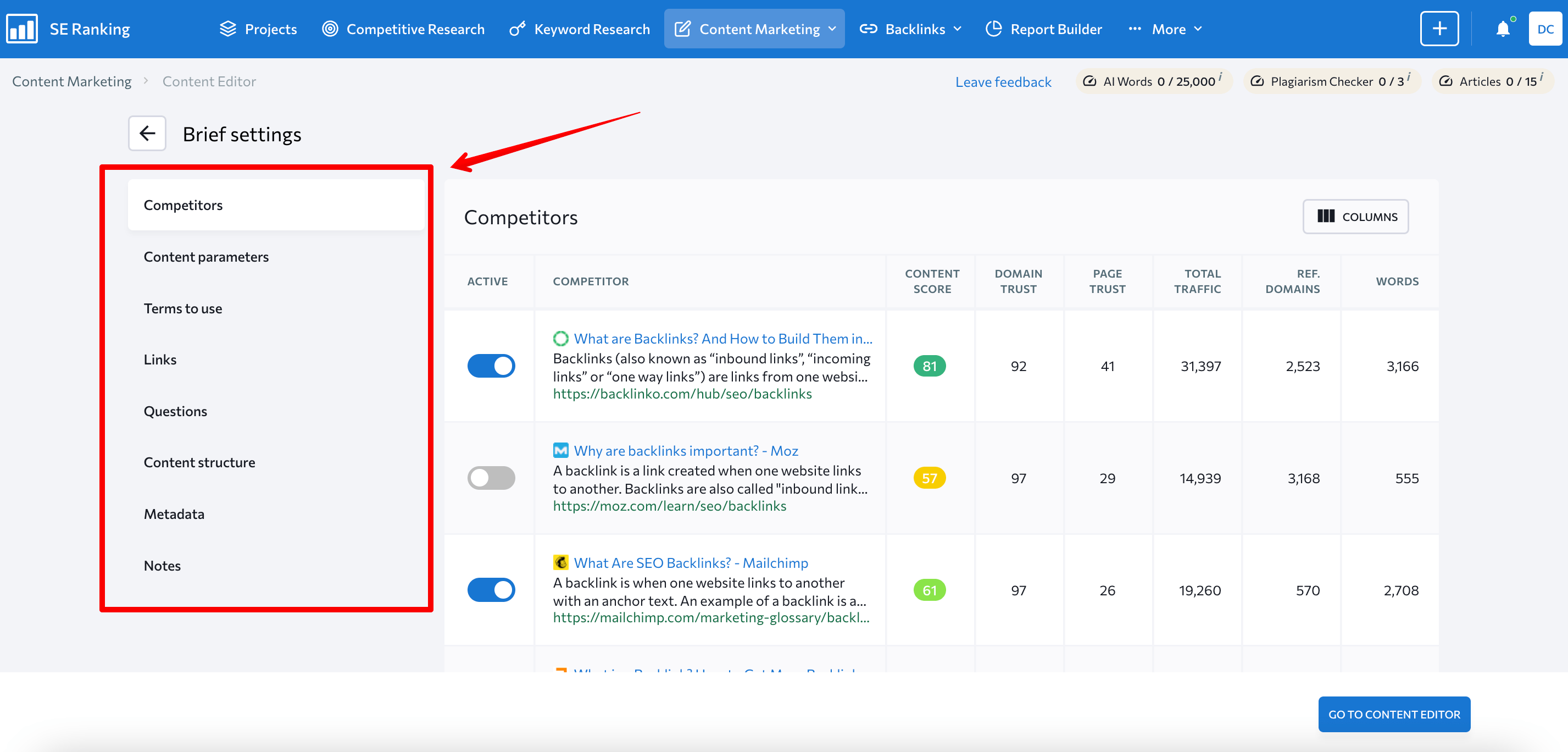
You can access these sections from the editor by clicking on the Brief settings button.
12. Generate a blog post
Creating engaging content that captures the attention of both users and search engines requires a great deal of effort. With Content Editor’s help, you can simplify and automate some of this work.
In the Article section of Content Editor, you can effortlessly create, upload, and edit your content. The tool offers a user-friendly interface similar to Google Docs, making the content creation process convenient and intuitive. SE Ranking’s Content Editor also enables you to rewrite the text. Just paste a piece of your competitor’s content into the tool and use our Rewrite feature. Another essential feature is AI Writer, which can generate topics and headings/subheadings, write unique paragraphs and even adapt the article to your target audience, offering 11 different tones of voice.
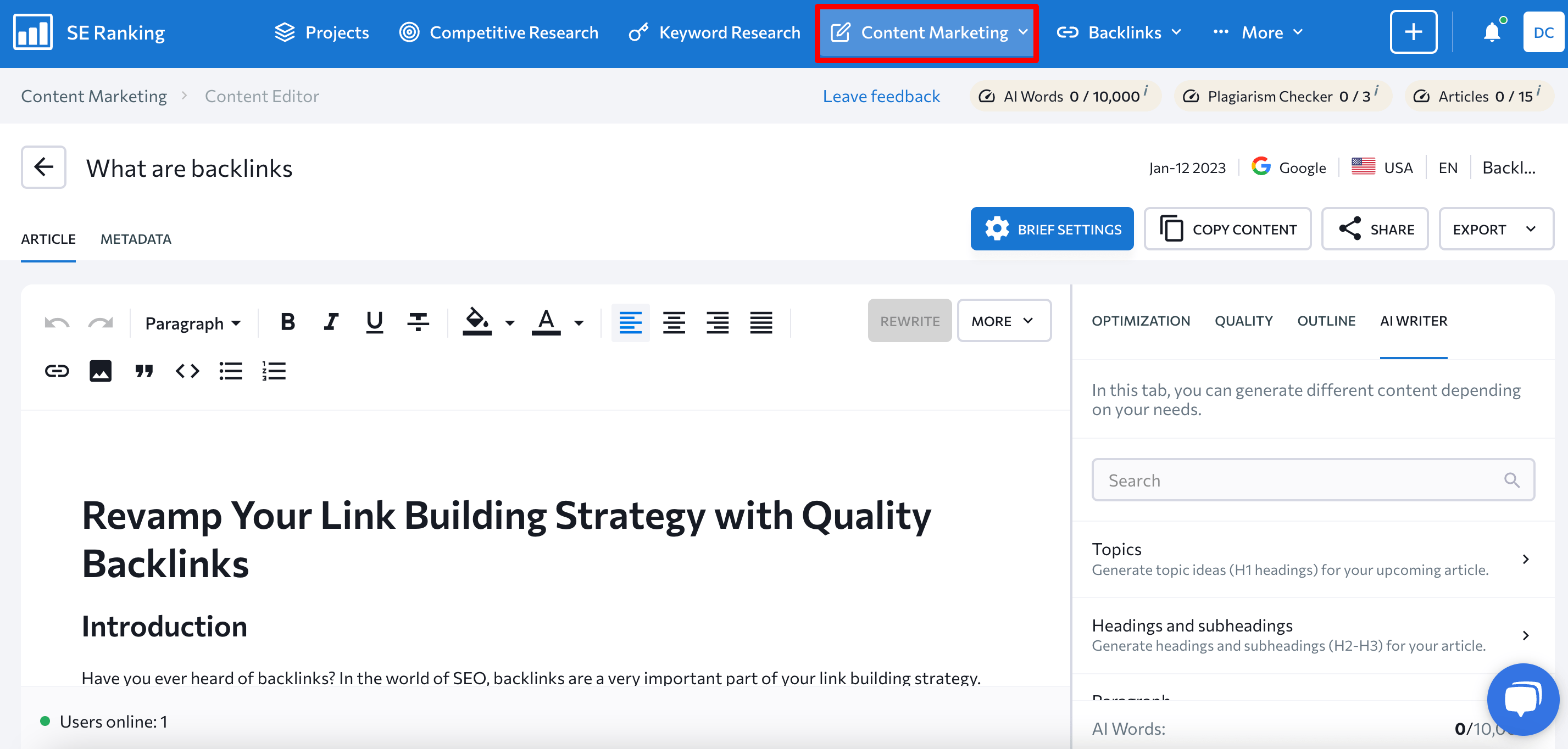
What’s more, Content Editor enables you to easily incorporate terms, links and questions specified in the brief directly into your article with just one click. You can also access recommendations for structuring your content and optimizing metadata.
13. Optimize a blog post
Content creation doesn’t end there. If you want your article to see results, it needs to be optimized. This is yet another area where our Content Editor tool comes in handy. It provides a range of features to help you optimize your content, including:
- Content Score: This is assigned based on how well the text covers the topic, including the number of words in the text, the keywords used, and their placement within the content piece. A higher Content Score increases your chances of ranking well in organic search results. The tool also provides competitors’ average scores to help you determine the score you will need in order to rank high.
- Brief Progress score: This shows how well your content meets the brief’s requirements.
- Plagiarism Checker: This checks your text for uniqueness so you can avoid publishing unoriginal material.
- Quality evaluator: This tool shows grammar and punctuation errors. It also reveals any stop words to avoid and measures text readability.
You can also track how many keywords you’ve already used and how many you still need to add.
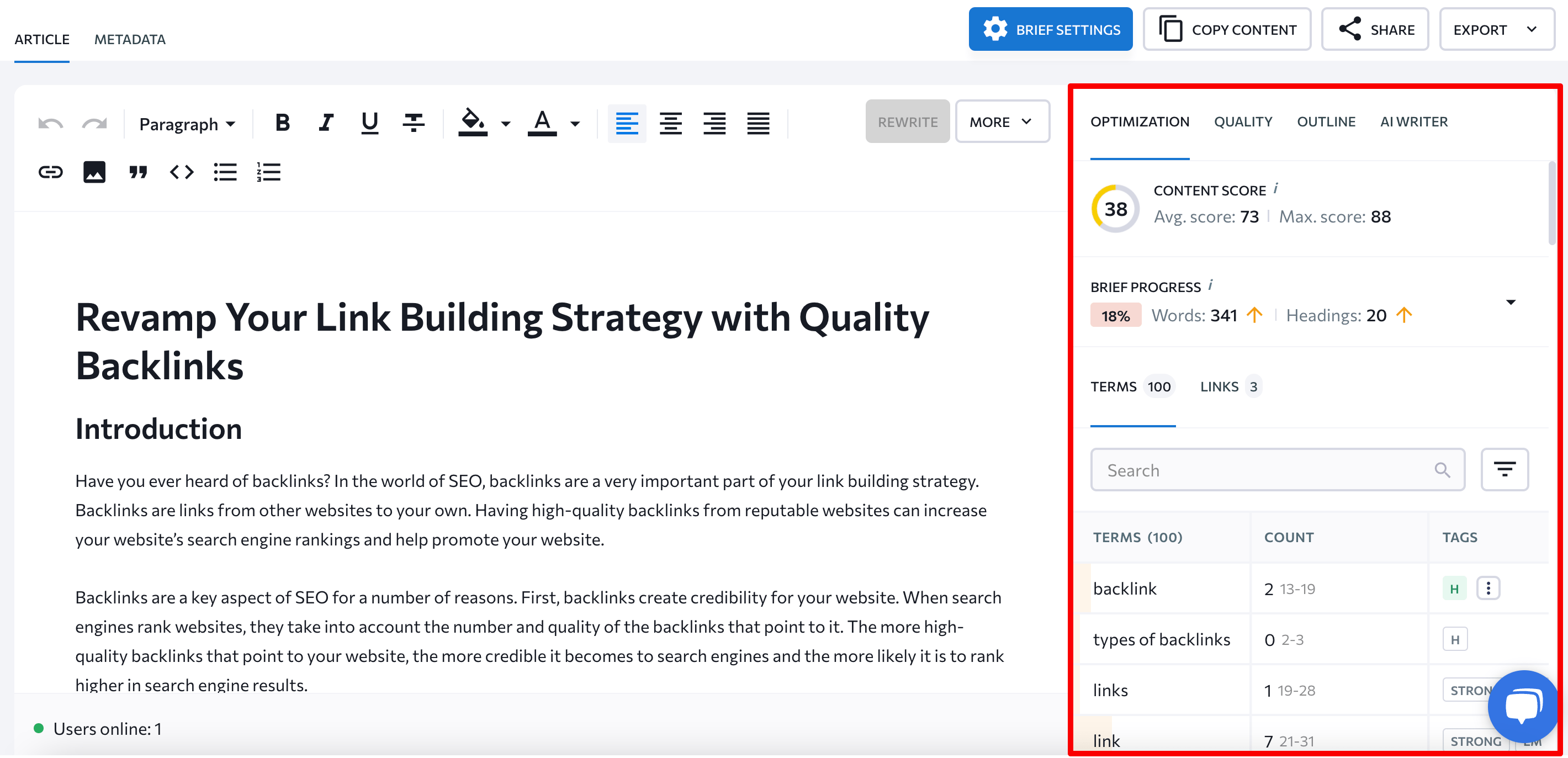
On-page optimization
14. Assess your site’s tech health
By regularly assessing your site’s tech health, you can identify and address any technical issues impacting your website’s performance, SEO, security, or user experience.
Since manually conducting technical audits is a resource-intensive process, you’ll want to use SE Ranking’s Website Audit. The tool scans the entire site using 130 parameters to identify dozens of technical errors and provides recommendations on how to fix them. SE Ranking automatically runs the Website Audit whenever a website is added as a project and sends you the report through email.
Go to the Overview tab to get a broad sense of your website’s technical health.
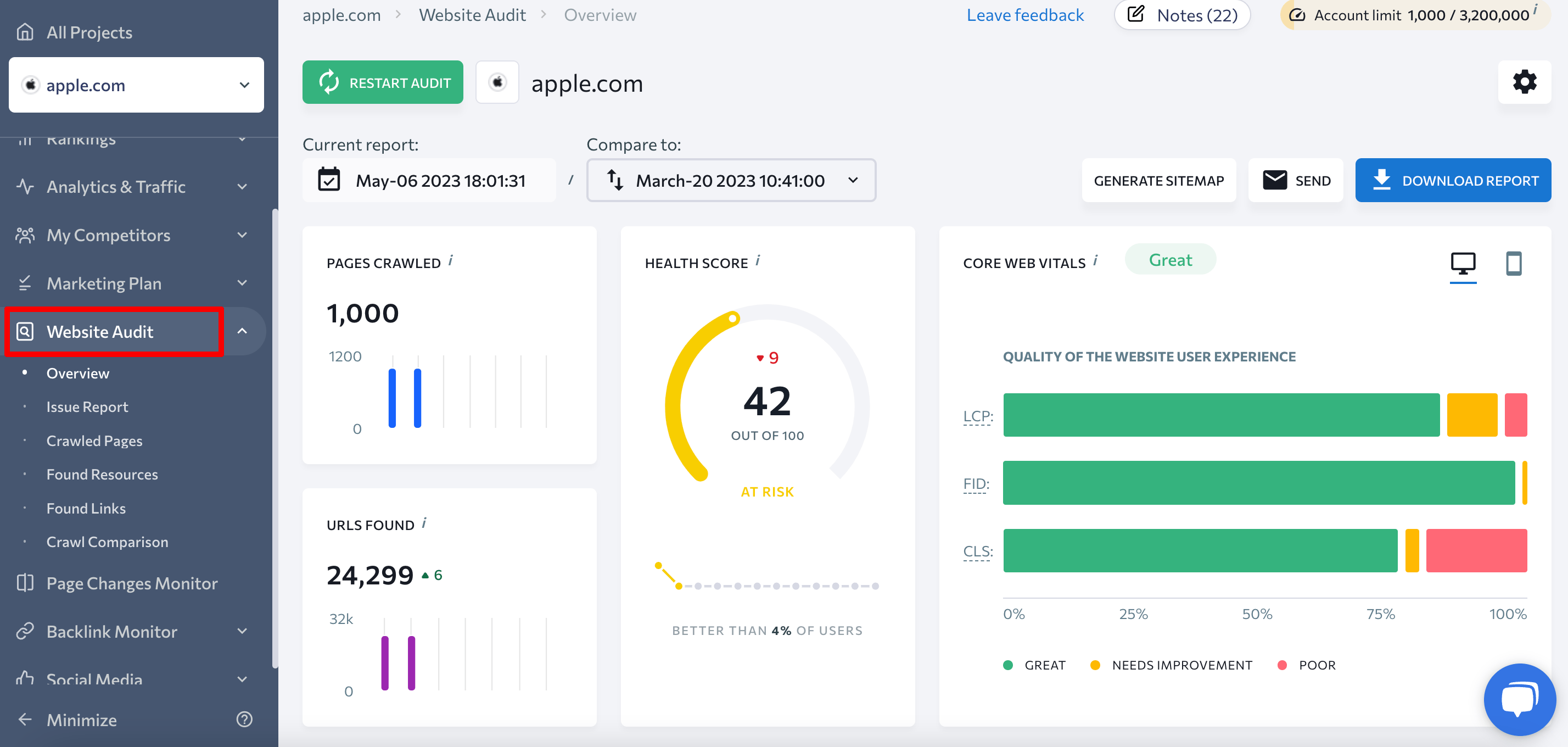
In this section, you’ll see the:
- Health Score calculated based on number of issue’s found and their severity.
- Number of pages crawled and URLs found.
- Core Web Vitals metrics and top five issues.
- Distribution of scanned pages across various issue categories.
- HTTP status codes and server response time.
- Number of redirects and detached pages.
- Link attributes, meta robots tags and more.
To compare the results of multiple audits and find the date an issue occurred, navigate to the Crawl Comparison tab. Choose two dates to observe the changes in the health score, improvements or deteriorations in metrics, and the correlation between the number of fixes and new errors.
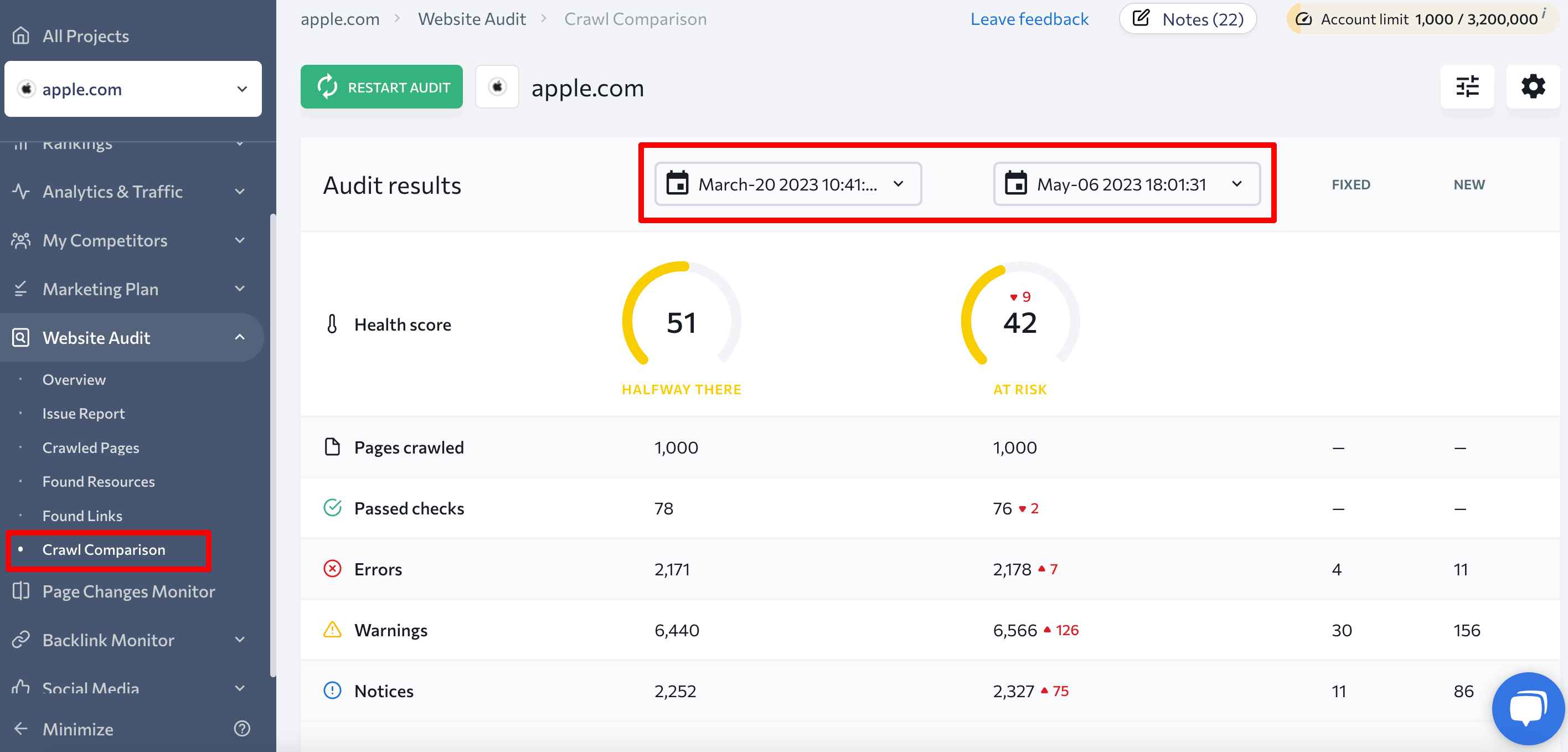
15. Fix crawling and indexing issues
Your SEO efforts won’t yield results if crawlers fail to scan your website properly. Crawling and indexing issues can occur for various reasons, including server errors, site structure issues or technical problems with your website. To ensure effective crawling and indexing by search engines, monitor your site using the Website Audit feature.
On the main dashboard, the Page Indexation section provides insights into the total number of website pages that were not indexed and highlights major issues that hinder their indexation. Click on the graph to see a list of indexed/not indexed pages, as well as pages with specific issues.
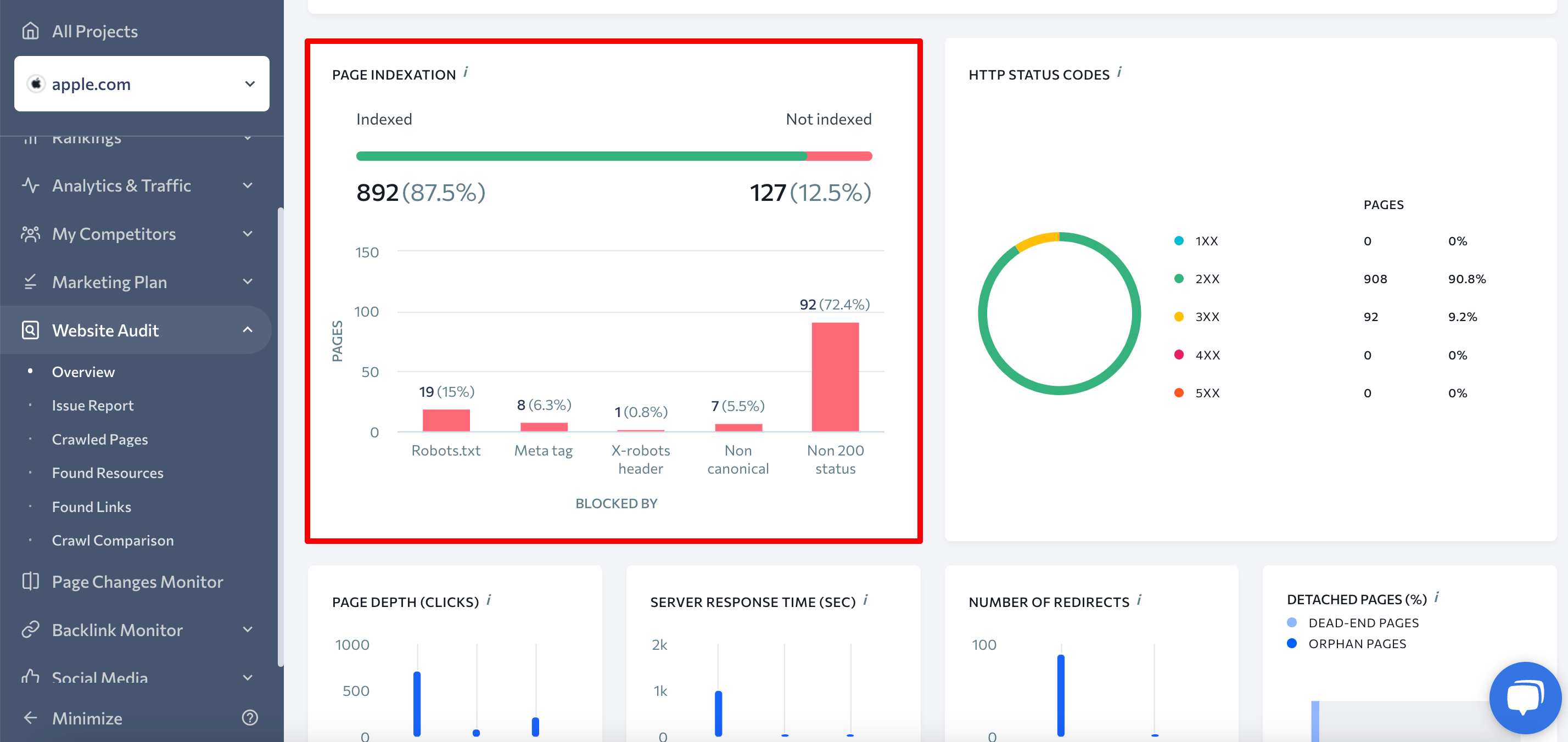
Pay attention to the Crawling section of the Issue Report. This section contains errors that can prevent search engine crawlers from scanning and indexing your site (e.g., sitemap and robots.txt file issues, errors in noindex and canonical tags).
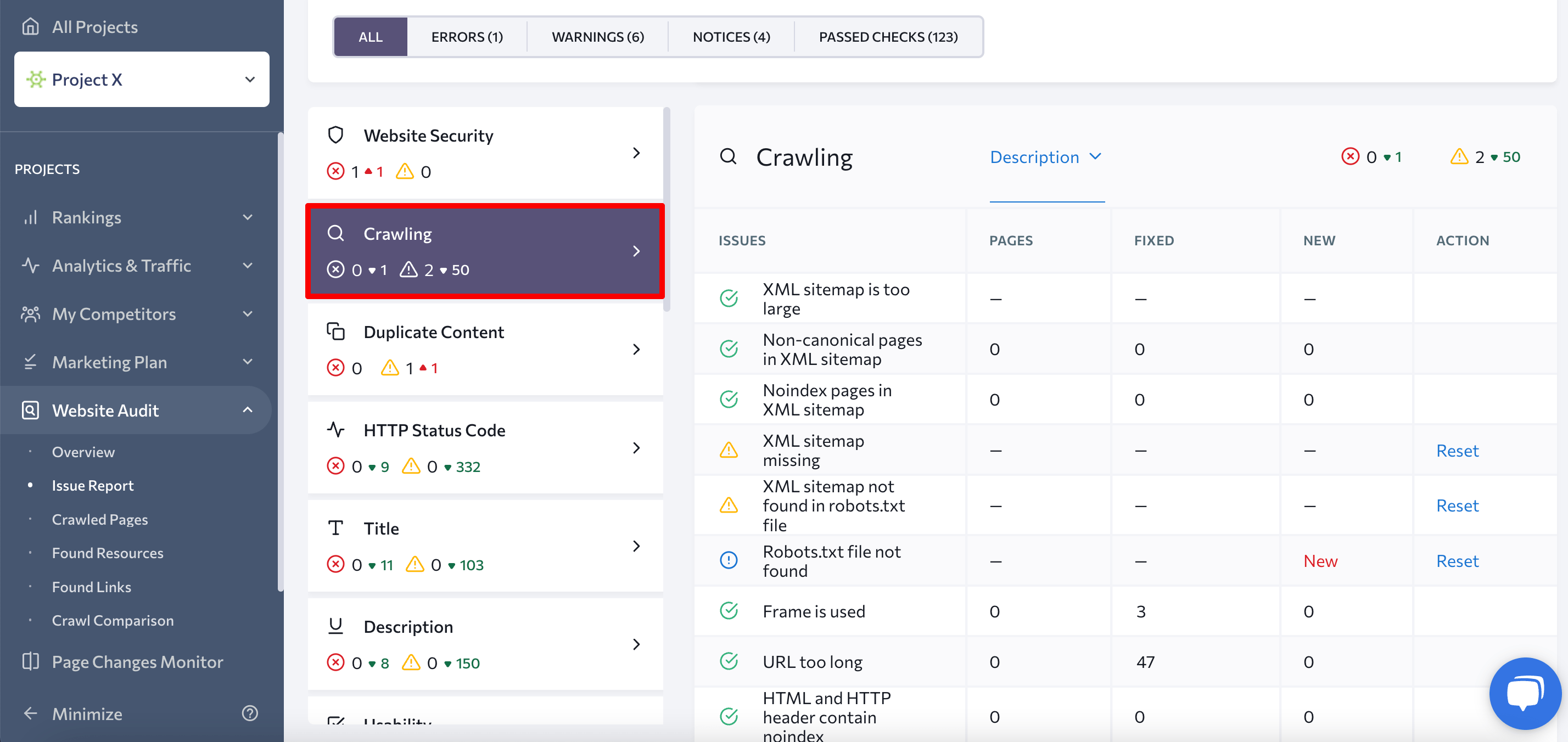
16. Improve Page Experience metrics
Page Experience metrics are a set of criteria that measure how user-friendly a website is. These include loading speed, interactivity, visual stability, website security and mobile-friendliness. By focusing on enhancing page experience and optimizing your website, you can create a positive and engaging experience for your users that will ultimately contribute to the success of your business.
Start by looking at the Mobile Optimization section of the Website Audit Issues Report. This section provides recommendations regarding the viewport meta tag, HTML code, and plugins that can assist you in making your website mobile-friendly.
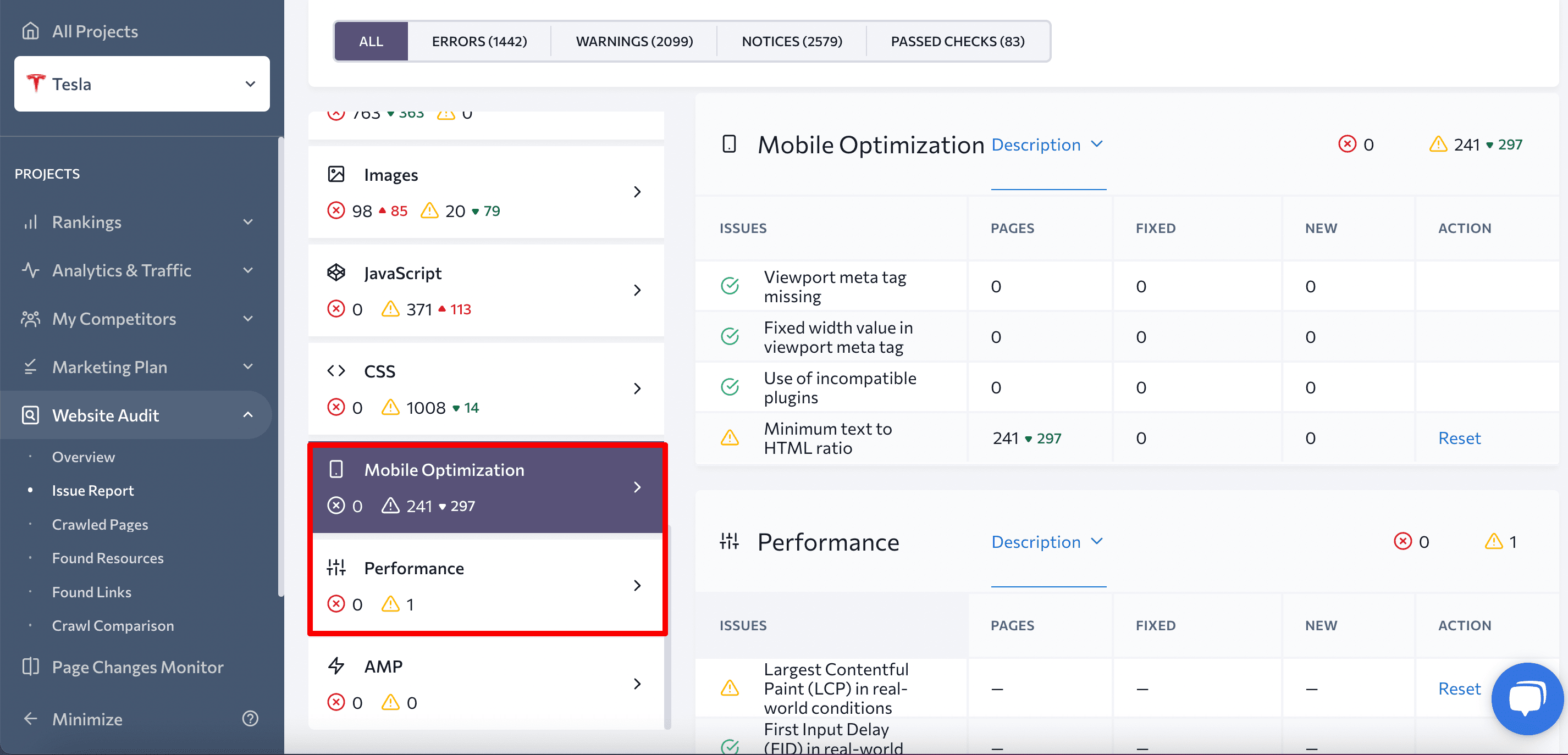
Performance is another section that comes in handy. It provides recommendations on website quality metrics that impact the user experience, including Core Web Vitals.
Next, examine the issues in the Website Security section, which highlight errors related to HTTPS functionality and the usage of HTTP links. Maintaining a secure encryption protocol is crucial for protecting user data, so do not overlook this section.
17. Remove page duplicates
If you have several duplicate pages, meaning those that only differ in the URL and appear due to technical issues, there’s a good chance the strength of your web pages will be diluted and, as a result, they will have issues showing up organically in Google searches. Because of this fact, it’s best that you remove every page duplicate.
In the Website Audit report, you can clearly see if there are any page duplicates on your website.
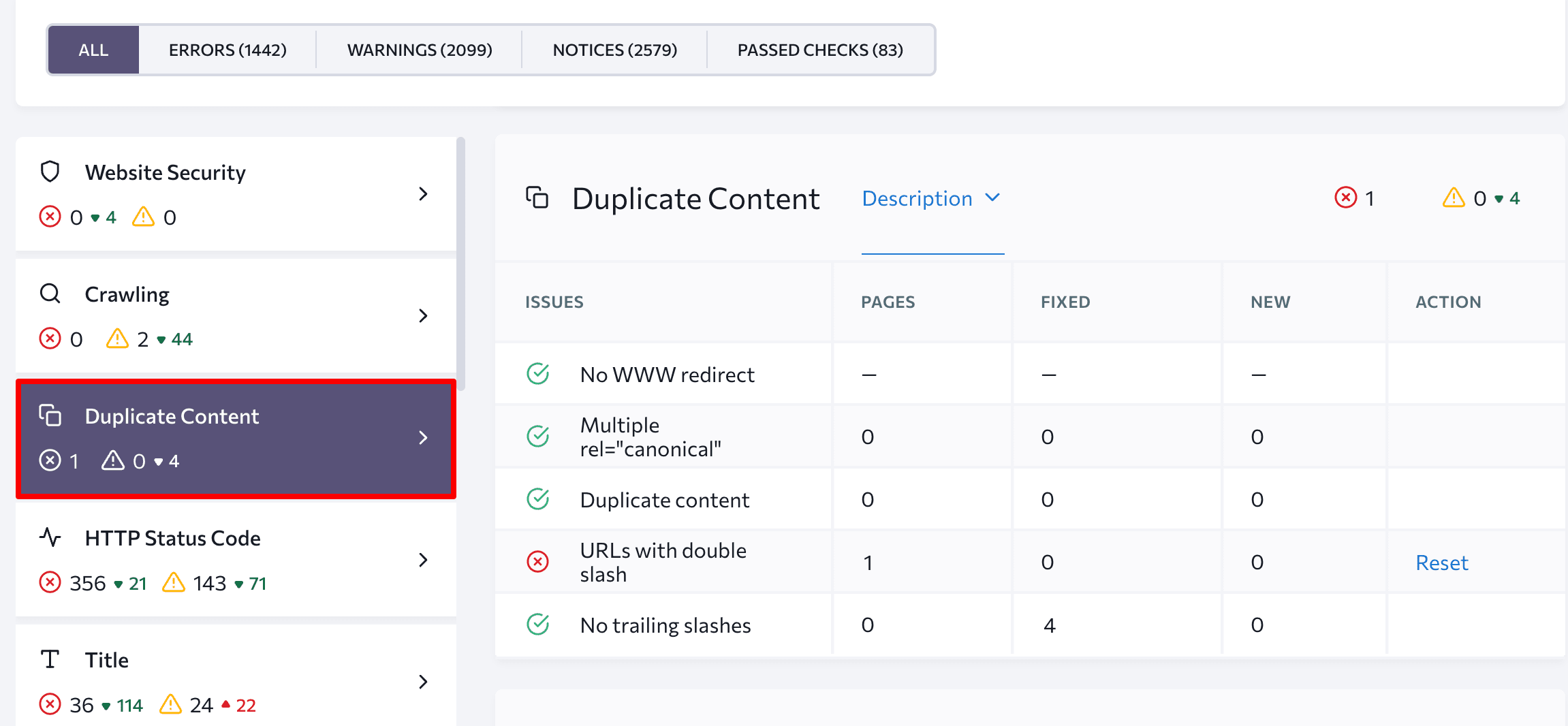
18. Optimize your meta-data
Website meta tags and titles must be unique, of adequate length, and contain target keywords. But most importantly, they must successfully tell search engines what each web page is about.
Description and Title tabs of the Website Audit report gives you an overview of your website’s pages. Seeing the full picture presents you with the opportunity to spot and quickly react to new issues. By clicking on the Pages column, you can access the full list of problem pages and work from there.
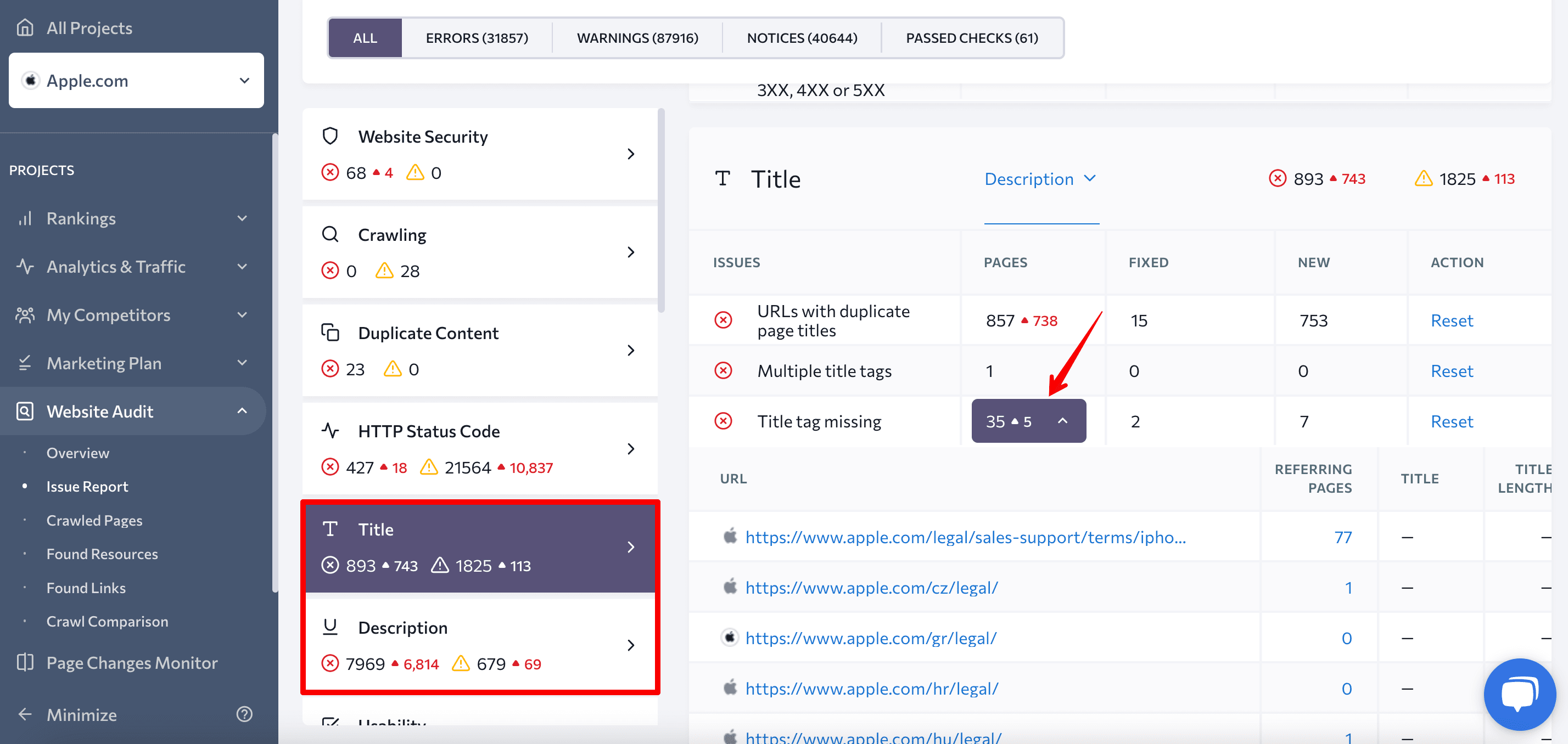
19. Resolve HTTP error status codes
In order to understand what information search robots get when crawling your website, you need to have the relevant HTTP status code stats on all of your pages. Ideally, all of your web pages should return the 200 OK status code.
Under the HTTP Status Code tab, you can see your web pages grouped by their status code, and analyze each group by clicking the number of pages in the appropriate column.
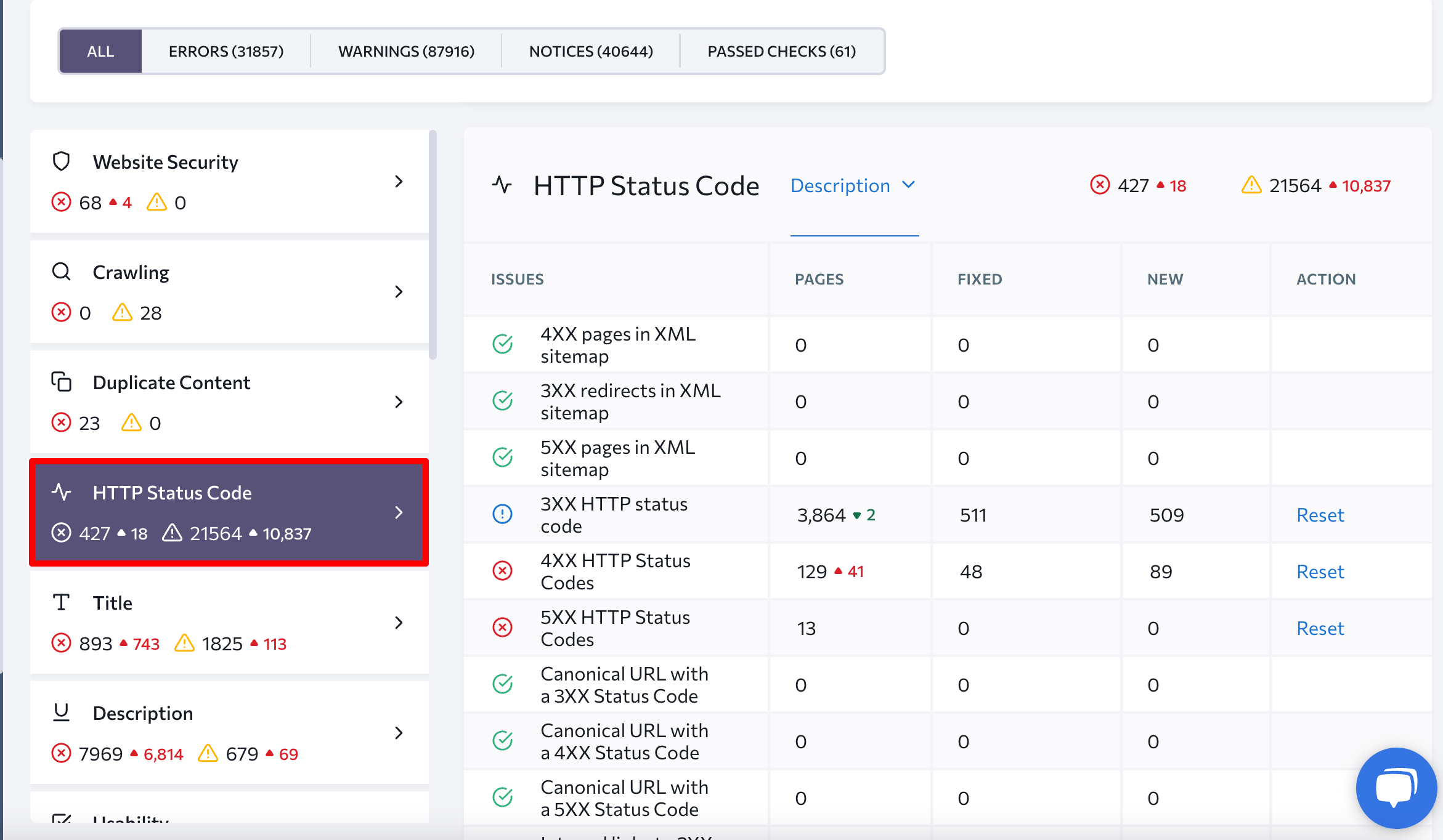
20. Fix broken links and redirects
The infamous 404 Not Found error code indicates that the page you are trying to reach doesn’t exist. This typically happens due to a broken link. Pages with broken links waste search robots’ valuable time and can even be an eyesore for visitors.
Another common problem is an excessive number of redirects. While the 3XX response code itself is not problematic, each redirect adds an additional burden on the server.
This is why broken links need to be found and fixed, so your site doesn’t collapse under its own weight.
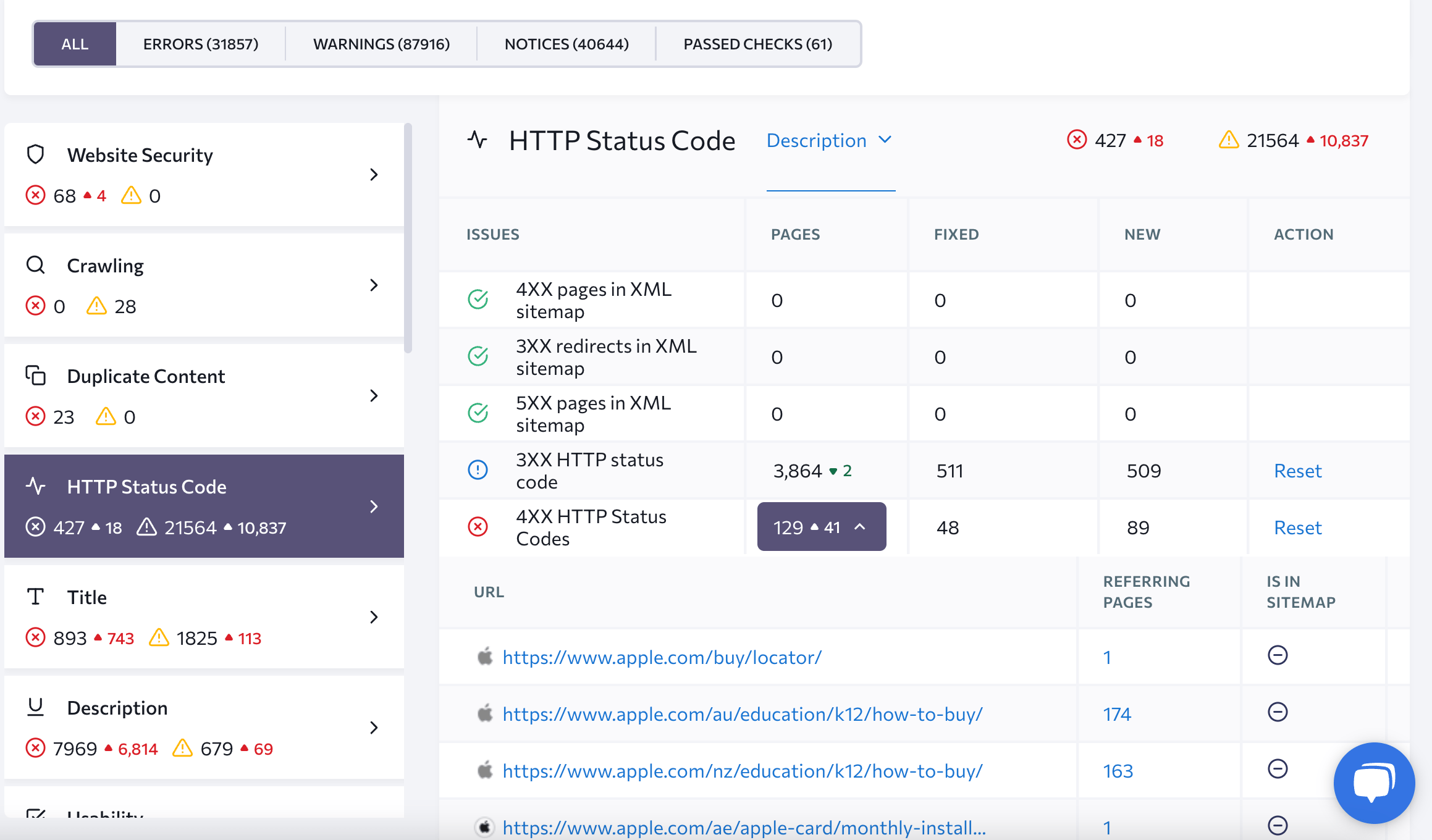
Pay attention to 4XX and 3XX Status Code issues under the HTTP Status Code tab.
Review your list of 4XX URLs and analyze every internal page linked to a 404 URL. Remove or replace broken links and ensure they are redirected to relevant and accessible pages. You can also set up 301 redirects when moving or deleting the site’s pages to prevent 404 errors.
Next, review the list of 3XX URLs and remove any unnecessary internal redirects.
21. Optimize images for search
To boost the likelihood of your images getting found in search, use the target keyword in image alt texts, the text around the image, the file name, and the page title.
The Images tab of the Website Audit tool provides a list of images found on your website that displays their URL, size, loading time and status.
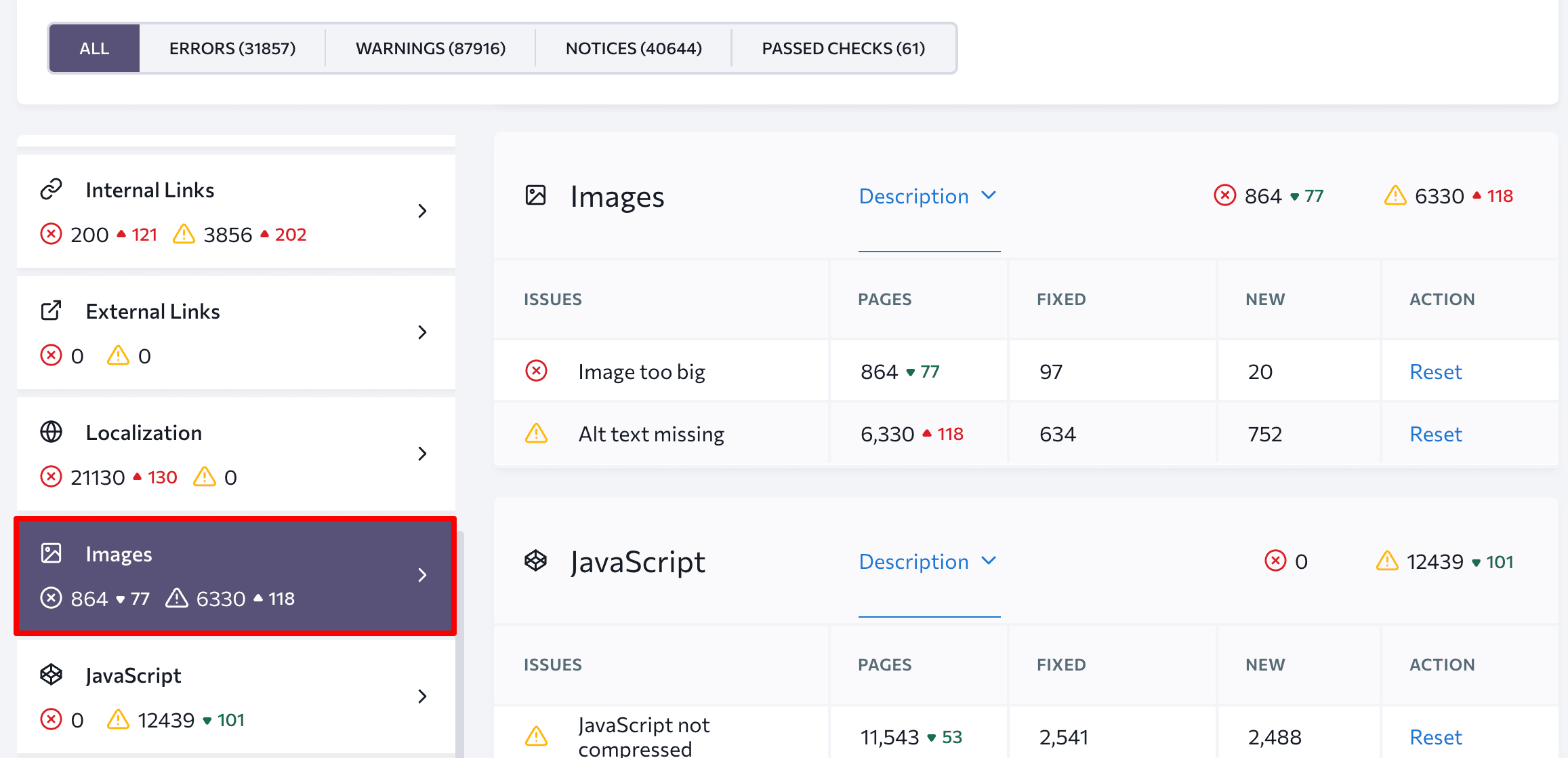
22. Improve on-page score of individual pages
Optimizing a web page for a specific keyword requires you to examine its meta tags, URL, content length, page usability, keyword density, and more.
With the On-Page SEO Checker tool, you can check all essential parameters at once. Simply enter the web page URL, target (and secondary) keywords, and within a few minutes, you’ll receive a detailed report with the Page quality score and a list of SEO tasks for improvement. The tool also offers fix suggestions based on the actual metrics of your top-performing competitors. You can even compare your terms, on-page metrics and content parameters with those of your competitors.
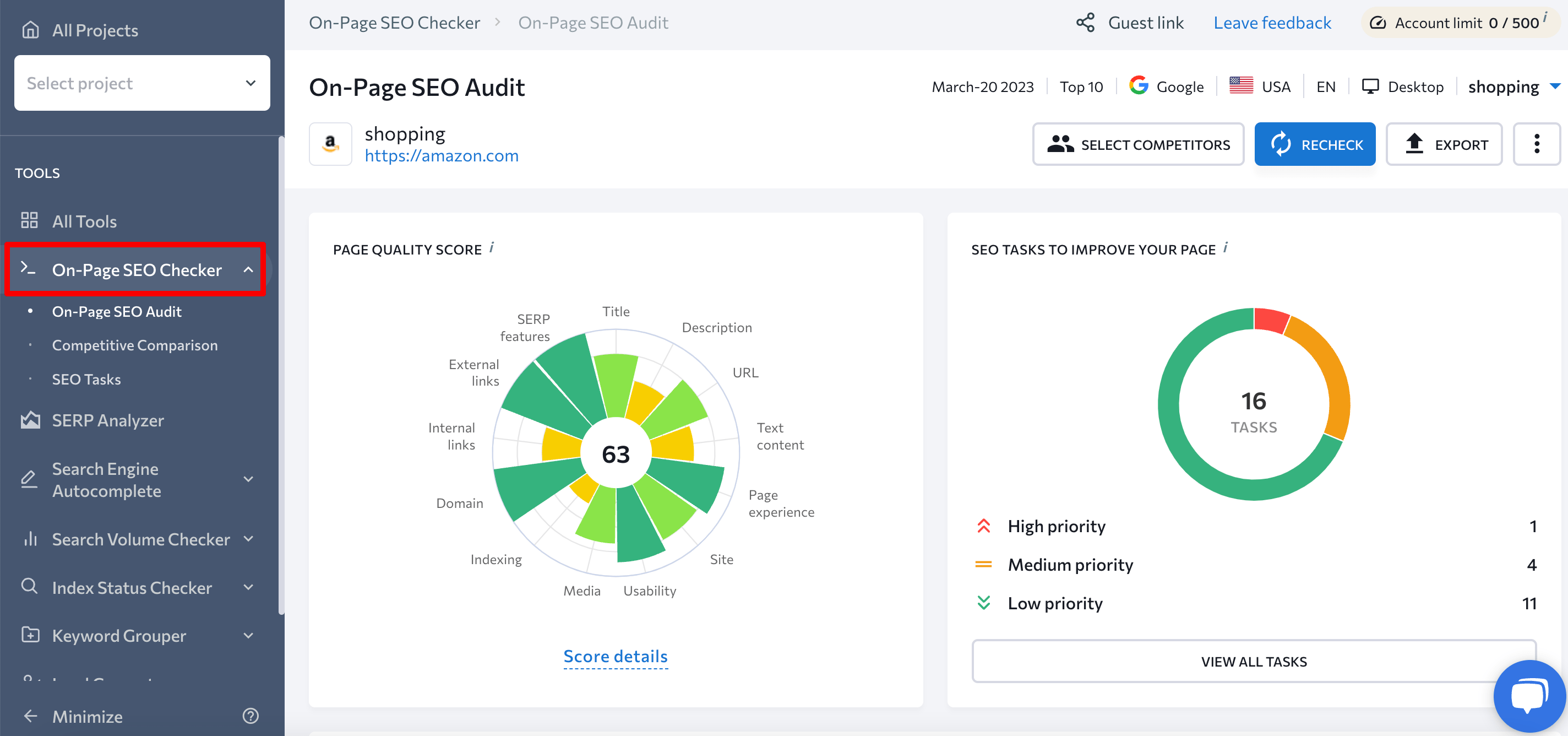
Off-site optimization
23. Get a complete list of backlinks from any domain
The quantity and quality of backlinks significantly impacts website rankings. This is why you need to know how many backlinks your website has, as well as the quality of each linking page.
The Backlink Checker tool gives you a list of every backlink, its referring domain and its data. Simply enter a domain or an exact URL, and if you want to scan the backlink profile of a specific page, hit Search. Then click on Get full report.
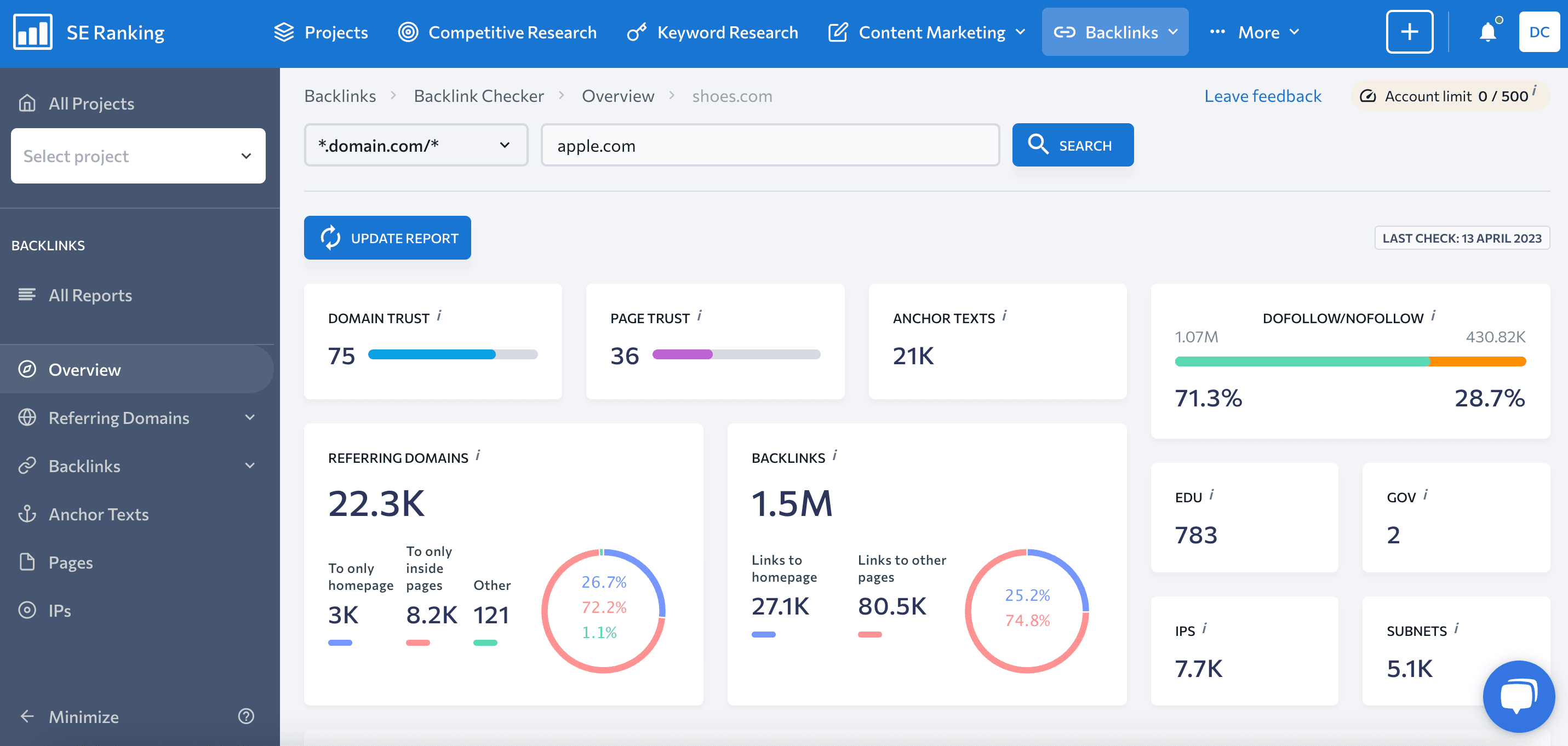
24. Analyze backlink gaps
Organically placing links on various platforms can diversify your backlink profile and drive your target audience to your site. But to find new platforms to link out to, you can always spy on the competition. Your competitors may have discovered valuable link-building opportunities that you can also take advantage of.
SE Ranking’s Backlink Gap Analyzer allows you to get a list of backlinks from multiple competitors, along with data on Domain Trust, Page Trust and anchor text.
By entering your domain and your competitors’ URLs, you’ll receive a detailed list of potential donor websites that are linking to your competitors but not to your website. Not only that, the Backlinks section provides examples of content that contain links to your competitors.
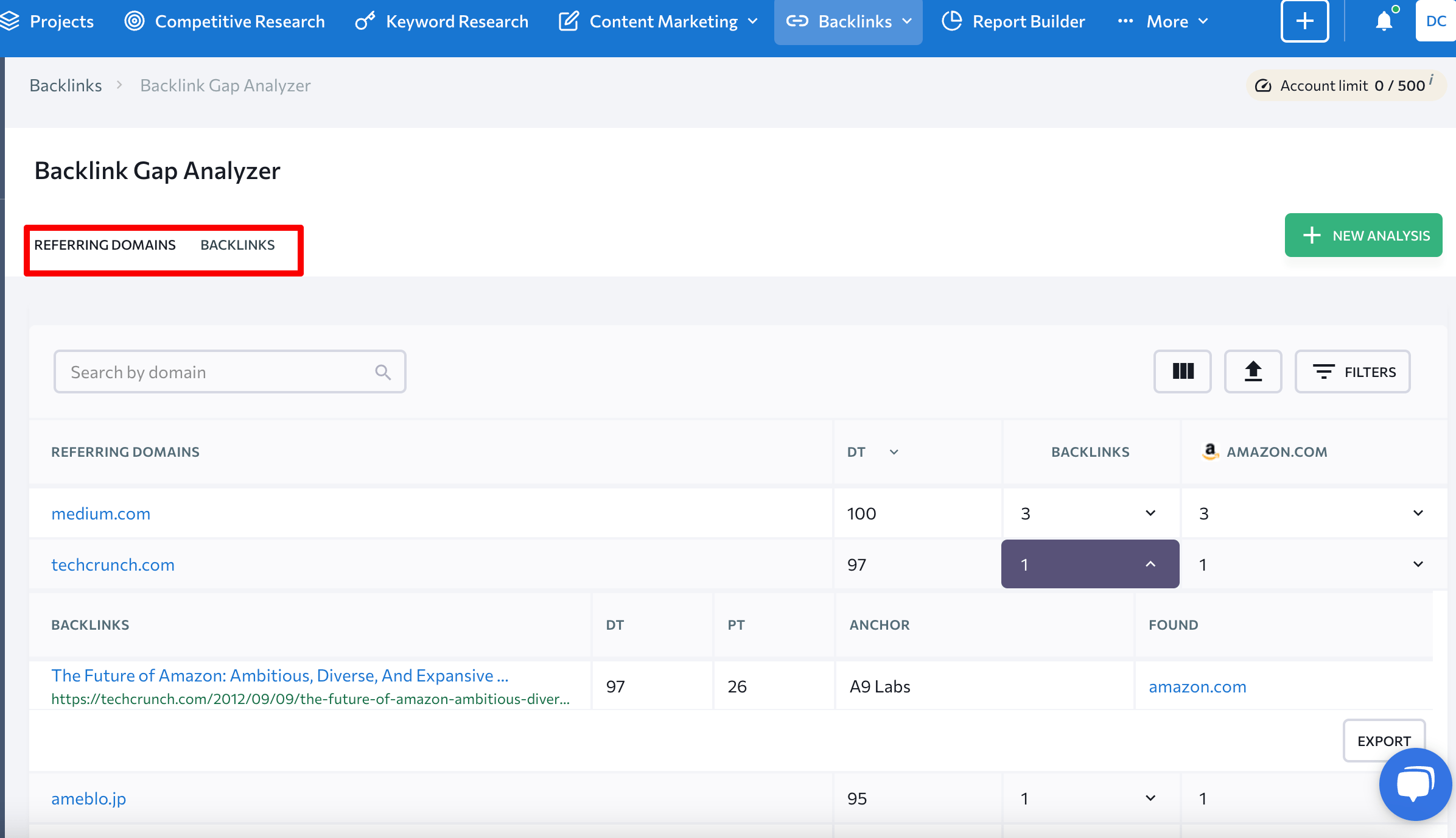
25. Check anchor texts, Domain Trust and dofollow/nofollow ratio
There are many metrics in off-page optimization that can impact the value of your earned backlinks. One of these metrics is anchor text, which is the clickable text used to hyperlink to another page. If your site has too many links with the same anchor text, or if the anchor text is not relevant to the linked page, it can harm your site’s ranking. This is why it’s important to regularly review your site’s anchor text and ensure it is optimized for SEO. The Backlink Checker tool provides a designated section where you can monitor all the anchor texts associated with your backlinks.

Another essential metric to consider is Domain Trust, which refers to the website’s authority. You can find this metric on the main dashboard of the Backlink Checker tool. It is calculated based on factors such as the number and quality of a website’s referring domains and backlink profile. A higher Domain Trust score signifies a greater level of authority for your domain, increasing the chances of your site ranking high in search results.
You should also pay attention to the dofollow/nofollow ratio, which can be found on the main dashboard. While some SEOs think that their link building strategy should be full of dofollow links and no nofollow links, the best practice is to have a balance between the two. The optimal ratio can vary greatly depending on your industry.
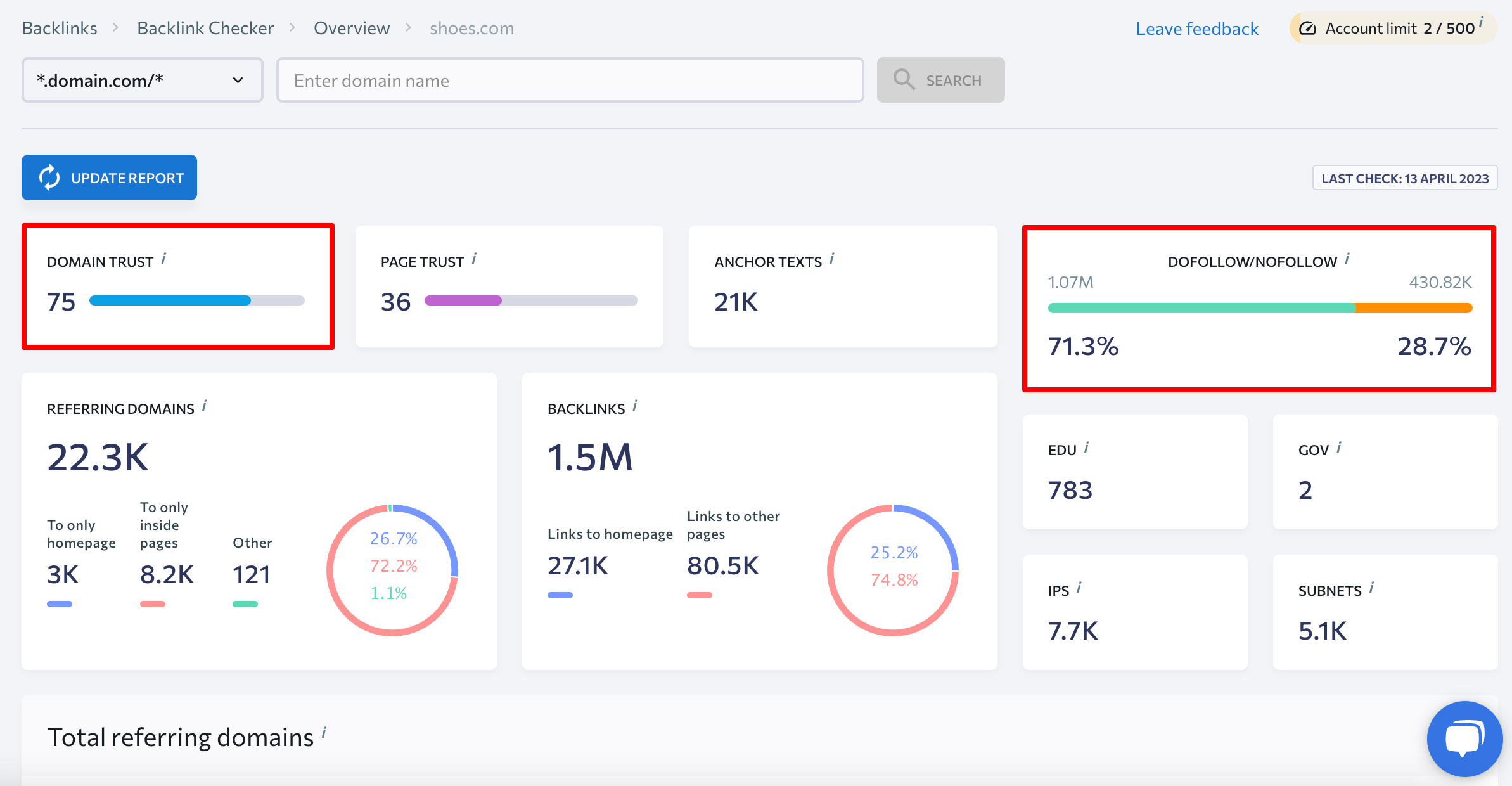
26. Monitor backlinks
Once you have the entire list of backlinks, add it to the Backlink Monitor tool. Doing so will enable you to keep a finger on the pulse of the backlinks and take timely action if anything changes.
In turn, the Backlink Monitor tool provides additional information on each added backlink, such as its overall and search engine index status, Domain Trust and Page Trust scores, destination URL, and anchor text.
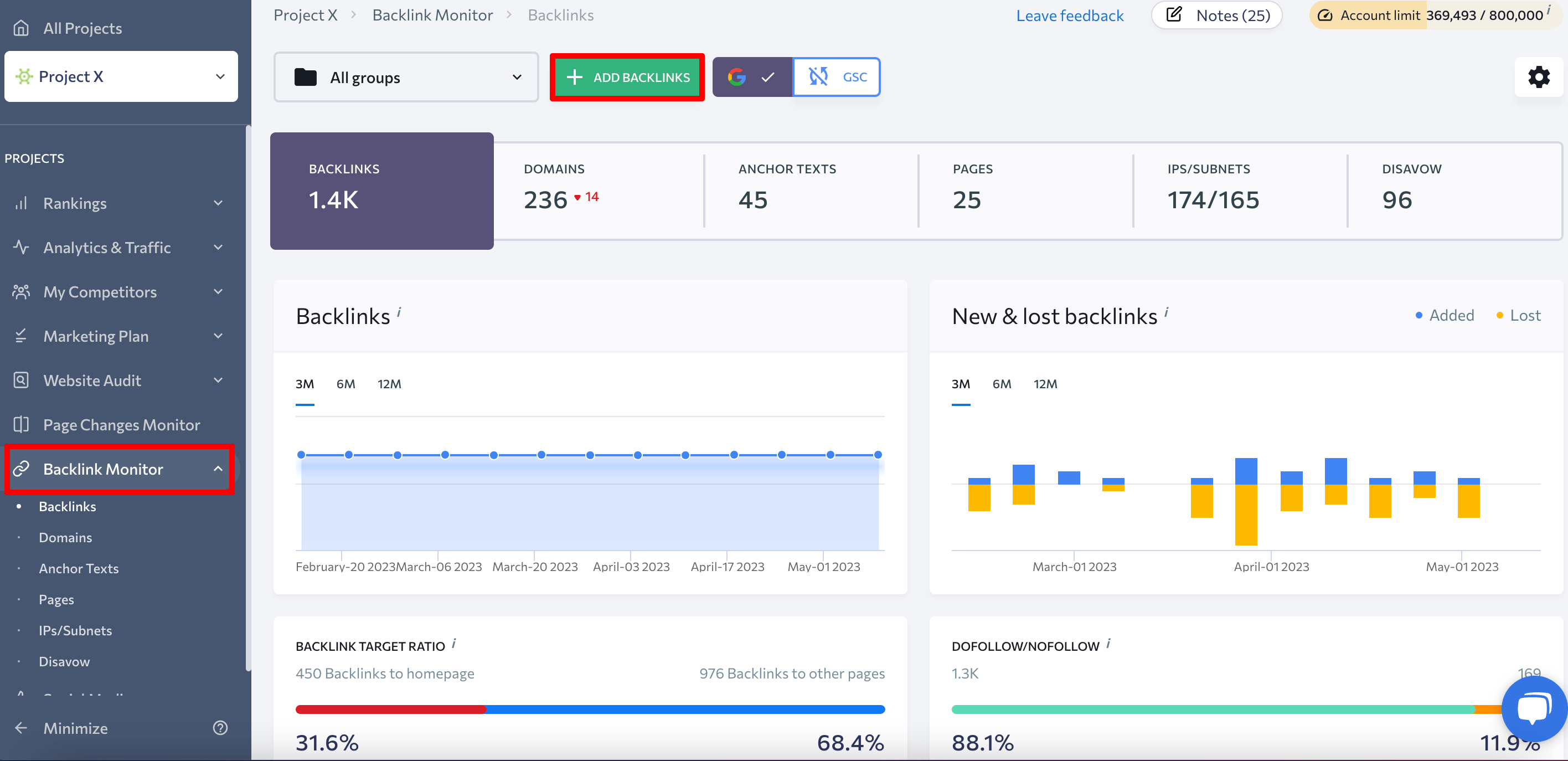
Competitor research and monitoring
28. Assess competitor traffic
When you know the traffic data of a competitor, you can make adjustments to your own site to be in tune with the market. Get answers to questions like how much paid and organic traffic they’re approximately getting, which countries and keywords is traffic coming from, what page are seeing most traffic, what marketing activities bring better results, and so on.
The SEO/PPC Competitor Research tool provides you with an overview of both paid and organic traffic along with the estimated monthly cost and number of clicks.
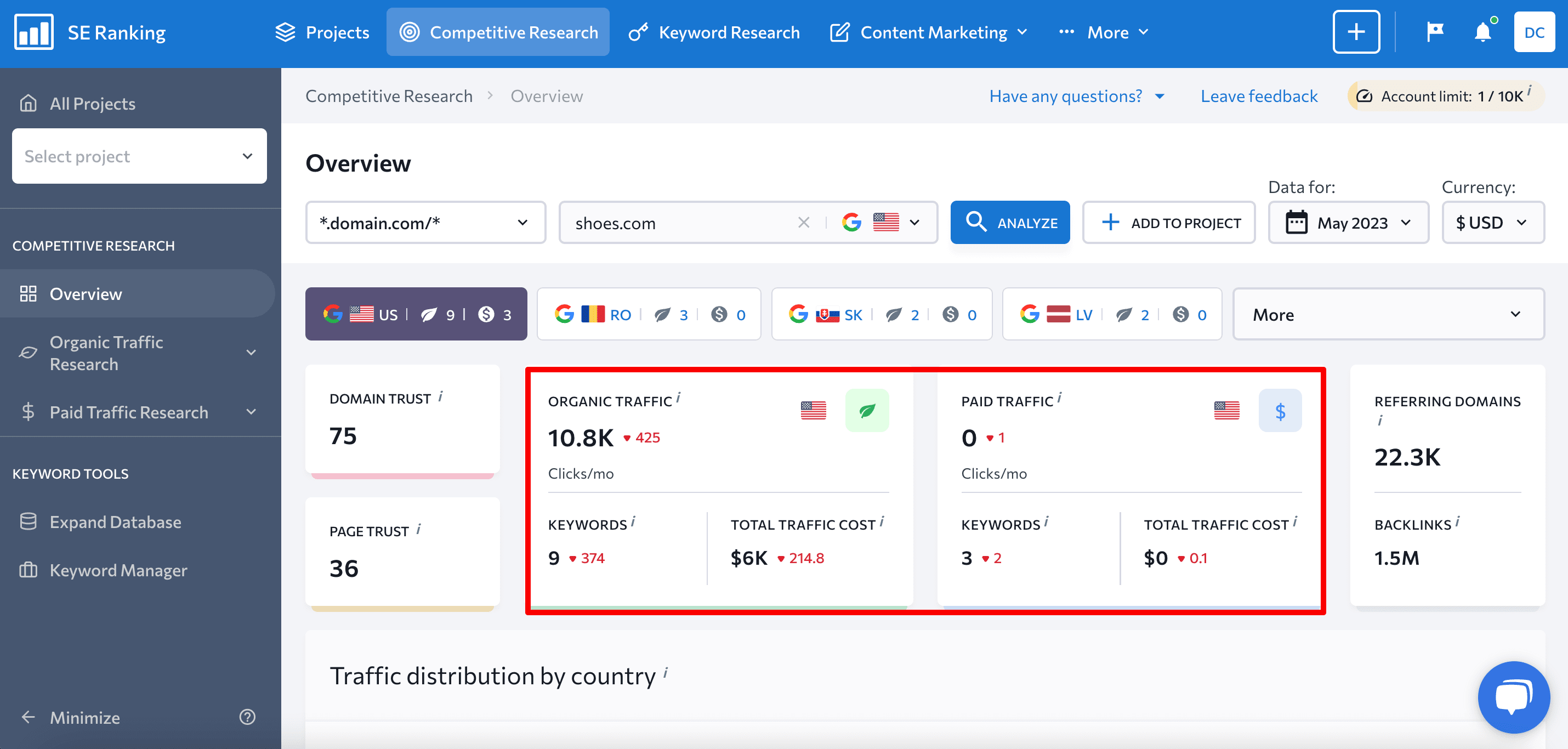
29. Check competitors’ top-ranking pages
Checking your competitors’ top-ranking pages can help you identify the content topics driving the most traffic to their site. Doing so can also keep you up-to-date on the latest trends and strategies used in your industry.
In the Pages tab of the Organic Traffic Research section, you will find a complete list of your competitor’s pages sorted by the amount of traffic they receive. By clicking on the link, you can analyze the content of the most popular URLs and gain inspiration for creating similar pages on your own website.
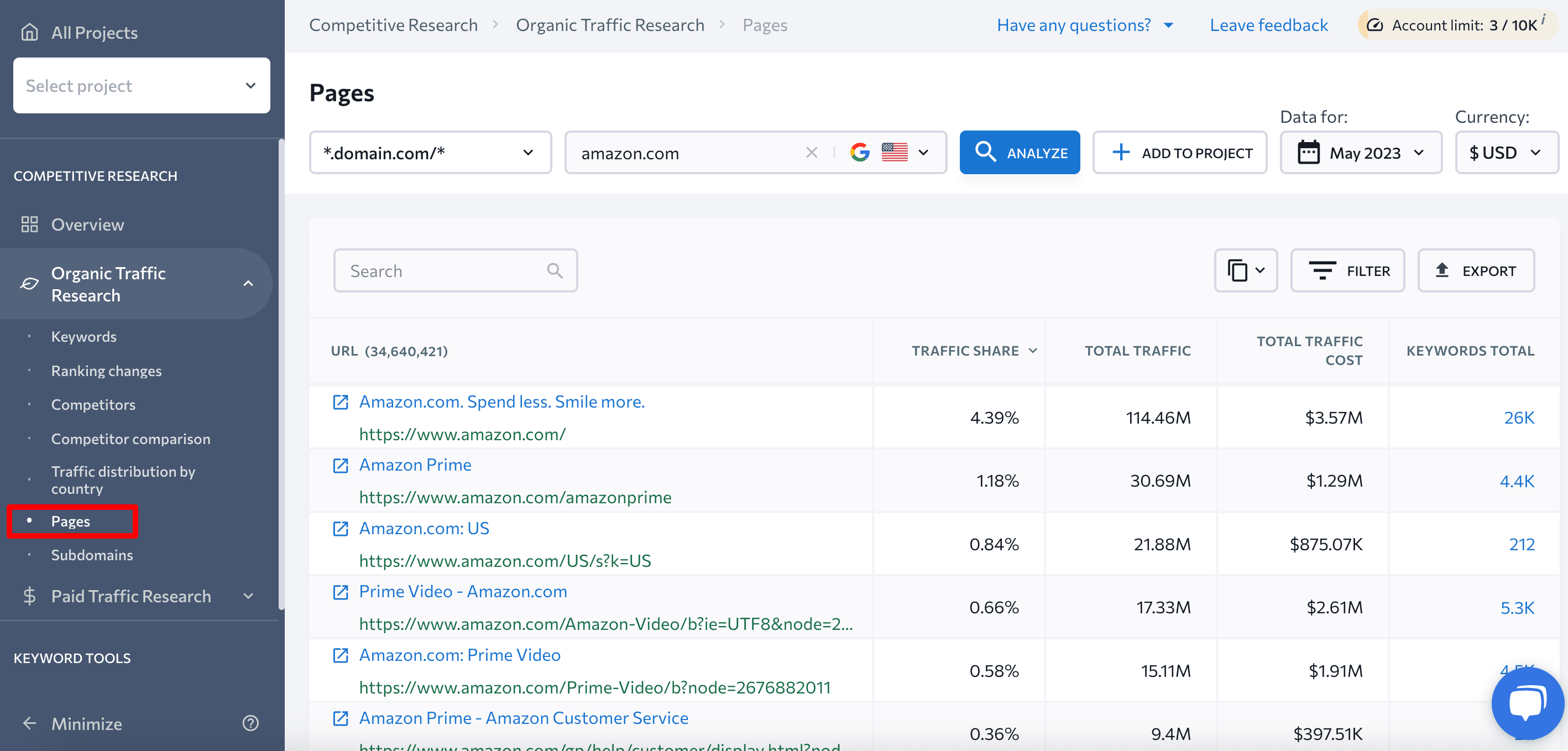
30. Identify pages with the most links
Analyzing a competitor’s backlink profile can provide valuable insights into their popular pages and promo activities. If a page has a lot of backlinks, it’s likely to be very popular.
To get a clear picture, simply sort the competitor’s pages in the Backlink Checker tool’s Pages tab based on the total number of backlinks they have. This will help you identify the pages that receive the most backlinks and gauge their popularity.
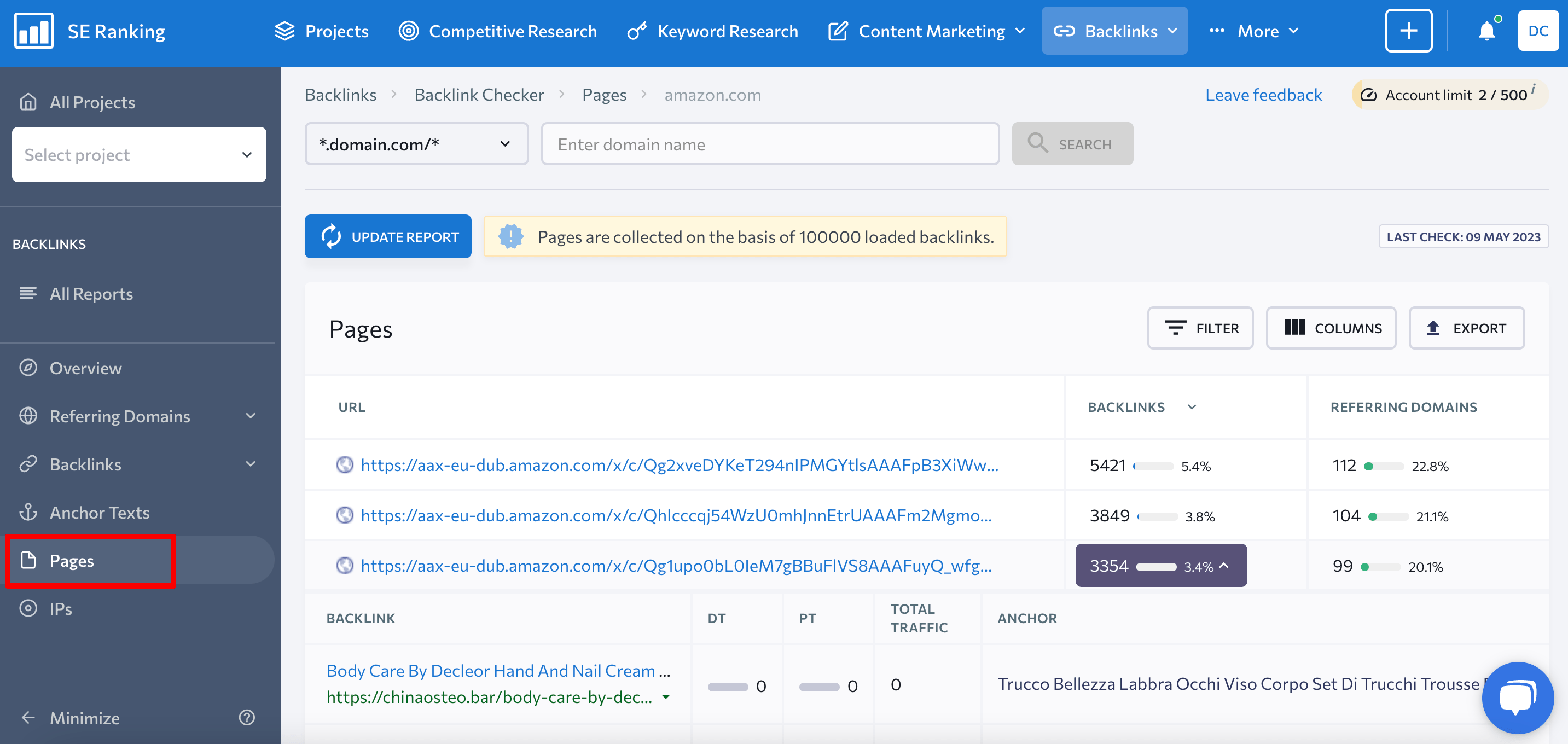
31. Monitor SERPs for your target keywords
Keyword search engine results pages are always changing. But you can analyze the top 100 search results to discover the frequency of changes in SERP leaders, the websites that consistently appear in the top 10 results, who’s new, etc.
With our SERP competitors feature, you can see the top 100 Google, Yahoo and Bing search results from practically anywhere in the world for every keyword tracked in your project. The tool can be accessed from the My Competitors tab. Just select a target keyword from the list, pick a time period (or several random dates), and look at how the SERP transformed over time.
What’s more, you have the option to tag the websites you’re competing with, allowing you to easily see your direct rivals and partners. You can decide how to label them based on your preference. It’s also possible to view data on Domain Trust, the total number of referring domains, and the total number of keywords the page ranks for.
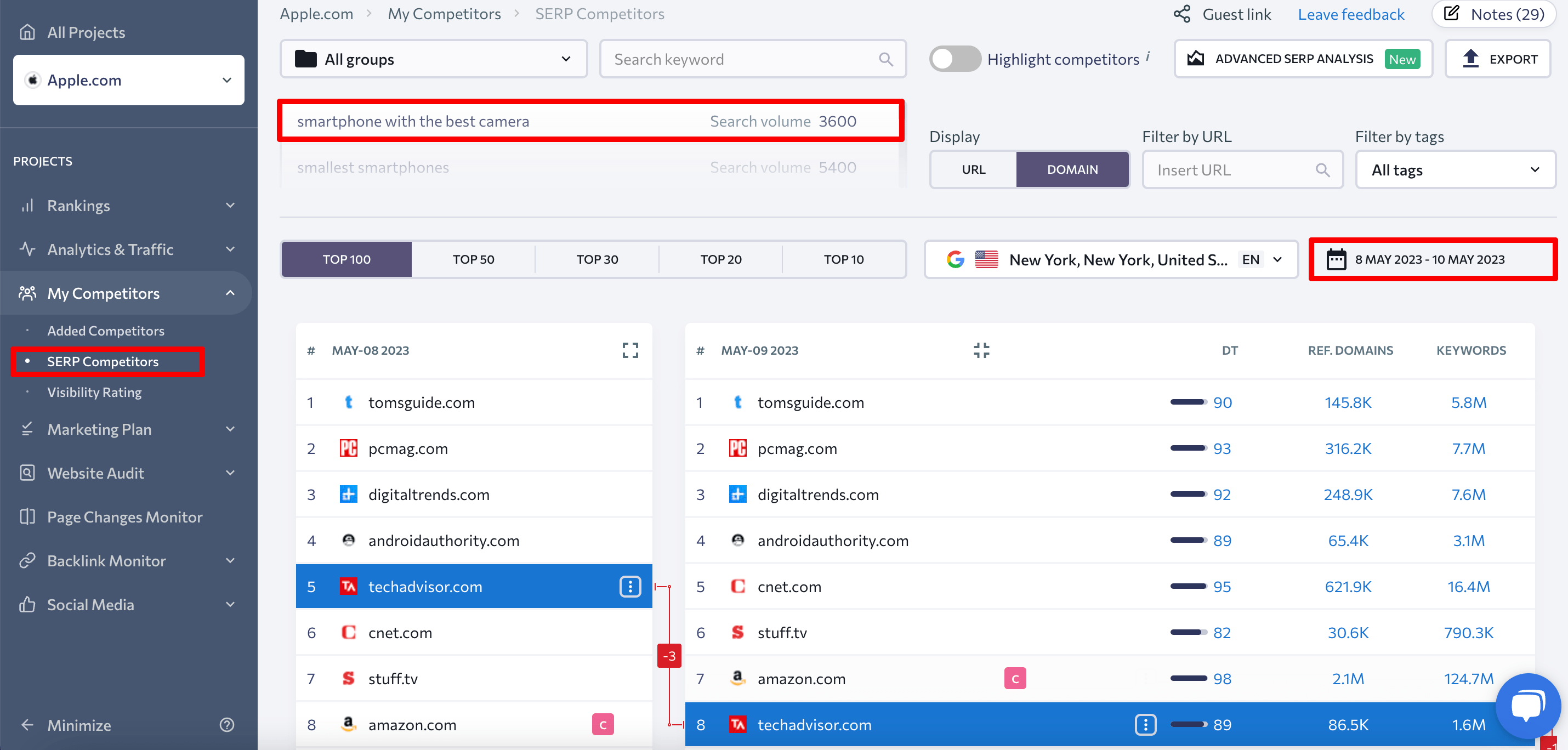
We also have an entire blog post where you can learn additional ways to use the SERP Competitors tool.
32. Keep track of competitor keyword rankings
Analyzing how your competitors are ranking for the same keywords that you’re trying to rank for will help you stay up-to-date on their ranking dynamics and overall results.
When you create a project in SE Ranking and add keywords that you want to track, you can conveniently add up to 5 competitors for free and track their rankings for the same keywords you’re using in your campaigns.
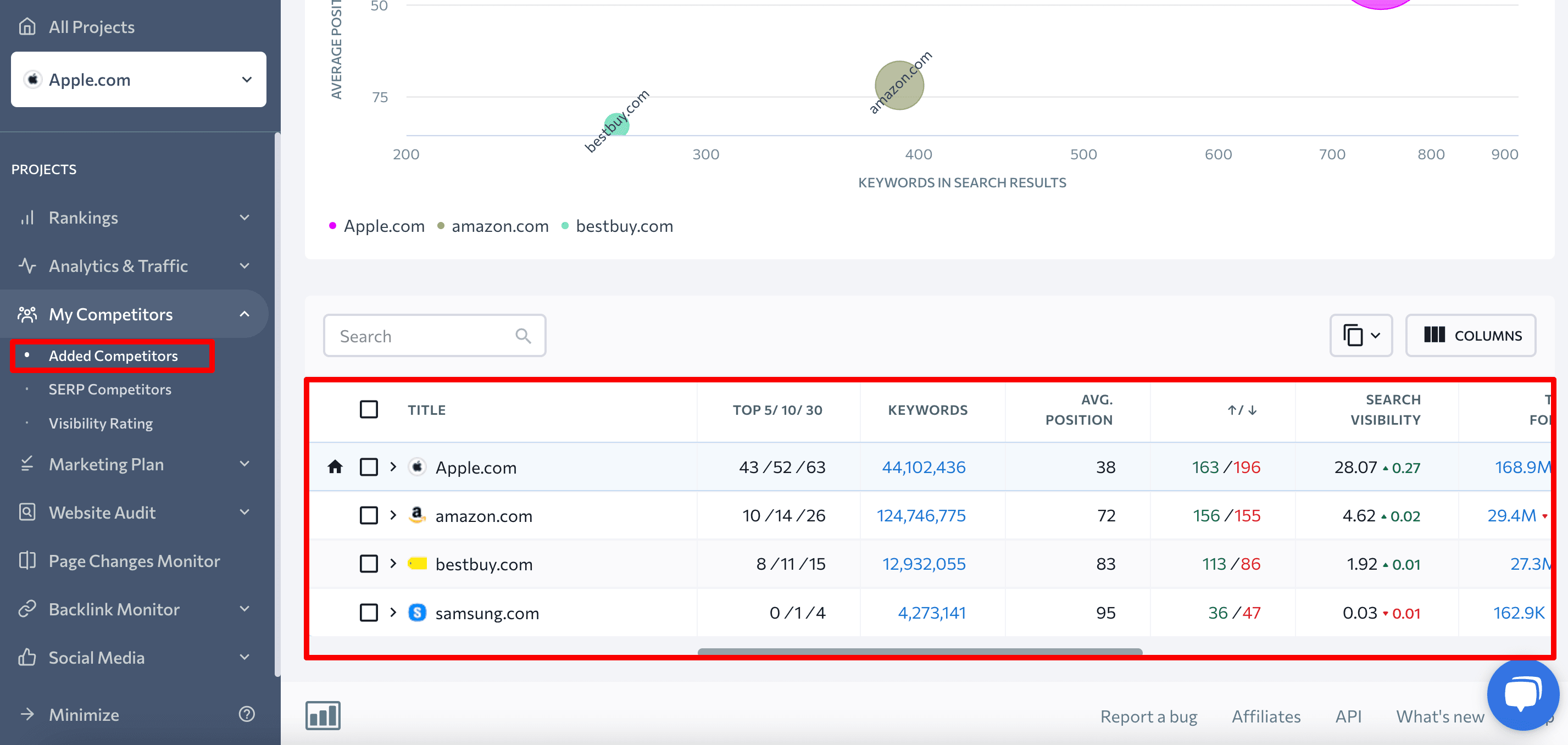
Result monitoring
33. Set up keyword rank tracking
There are several things you need to take into account when tracking your website’s keyword rankings: search engine, language, and location. Sure, you can track keyword rankings manually, but it’s practically impossible to do, especially if you have thousands of keywords in your keyword list. So why not track keyword rankings automatically?
Our Rankings module takes every vital factor into account: location, search engine, device (mobile or desktop), SERP features, Google Maps, Google Ads, and even YouTube rankings. You’ll be walked through the entire setup process as you’re adding a website to SE Ranking.
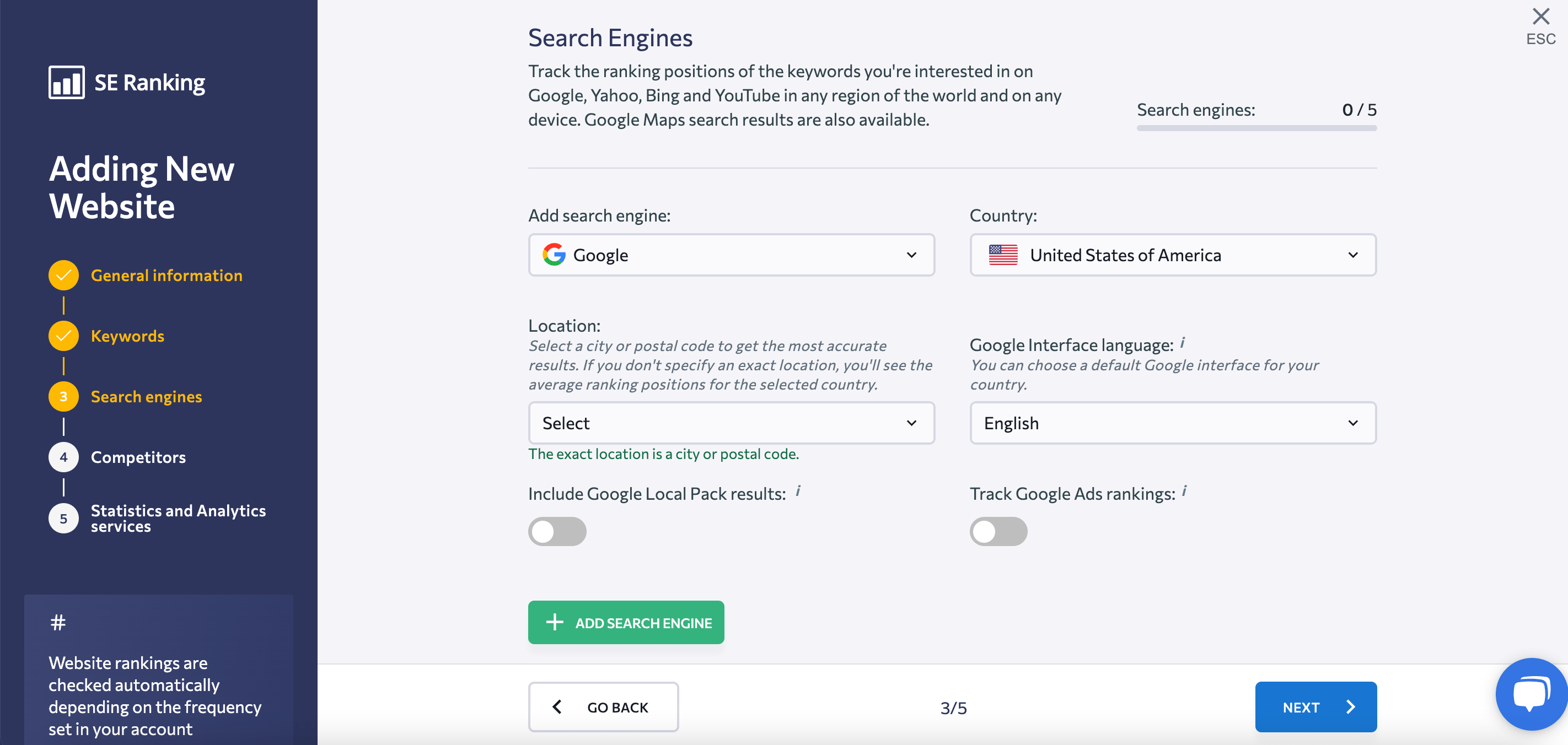
34. Integrate your GSC and GA accounts
By connecting your GSC and GA accounts to SE Ranking, you can conveniently access all your data in one unified platform. These integrations offer valuable insights into your website’s search engine performance, enabling you to make data-driven decisions to improve your SEO strategy.
In the Analytics & Traffic section, you’ll see stats on your website visitors. This includes info on their geographical locations, number of sessions on your pages, traffic sources, bounce rate, conversion goals, and much more.
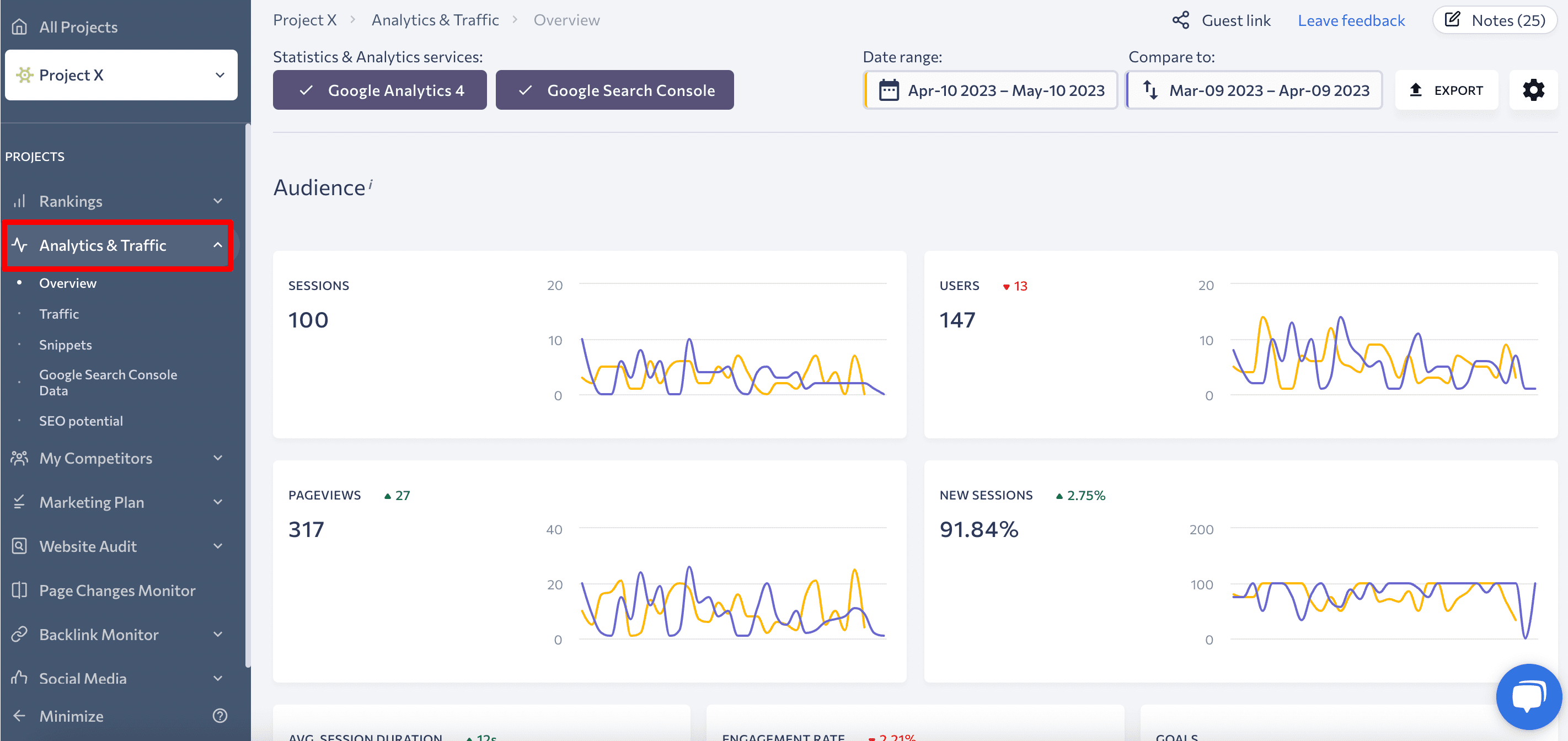
35. Start tracking down keywords you already rank for
Another task that’s easy to complete with SE Ranking’s Google Search Console integration is staying updated on keywords you already rank for. This integration provides detailed GSC data for each keyword, including its current and average position, the number of clicks on your website, how often your site appears in search results, and the CTR for a given period. SE Ranking also offers its own precise date on keyword positions. Keywords that are not currently tracked by SE Ranking—meaning that they are probably off your radar—will be marked as Not tracked. To start tracking these keywords, simply tick them and click the Add to the project button.
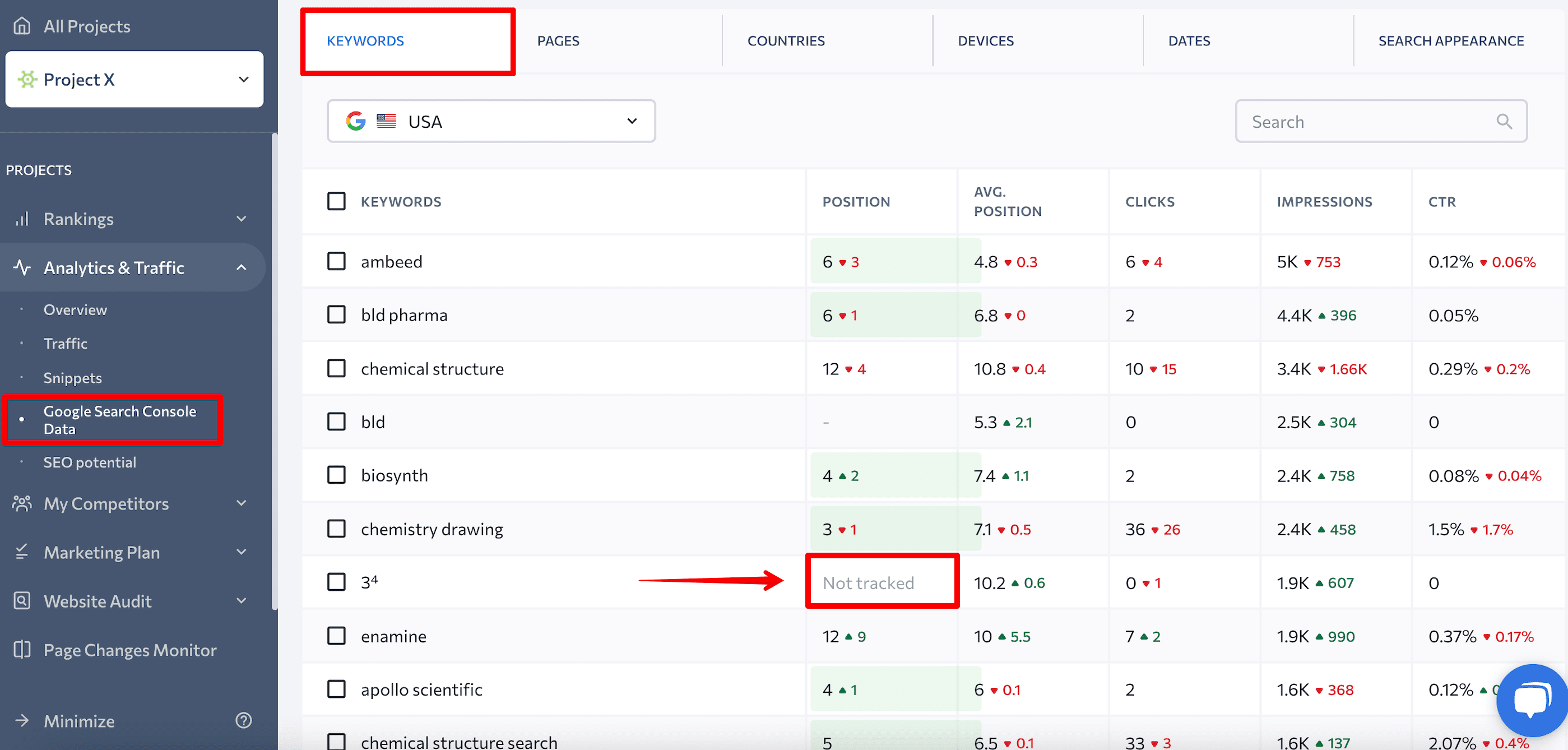
36. Monitor all website changes
When several people have access to a website and make changes to it without letting others know, things can get out of control. This is even more noticeable if you work in an agency setting where different people handle different aspects of optimization. Your client will also make changes, so it’s important to keep track of what they’re changing and how often they’re changing it. Without you even knowing, a keyword can be removed from a page title, a new headline can appear, or a new link can be added. Inconvenient changes like these can negatively impact your website’s SEO.
SE Ranking’s Page Changes Monitor tool lets you stay up-to-date on all the changes made to a website through its intuitive interface. It provides configurable notification options, ensuring you receive timely alerts. The tool’s main job is to keep an eye on all of the content, such as removals and edits, as well as modifications to metadata and links.
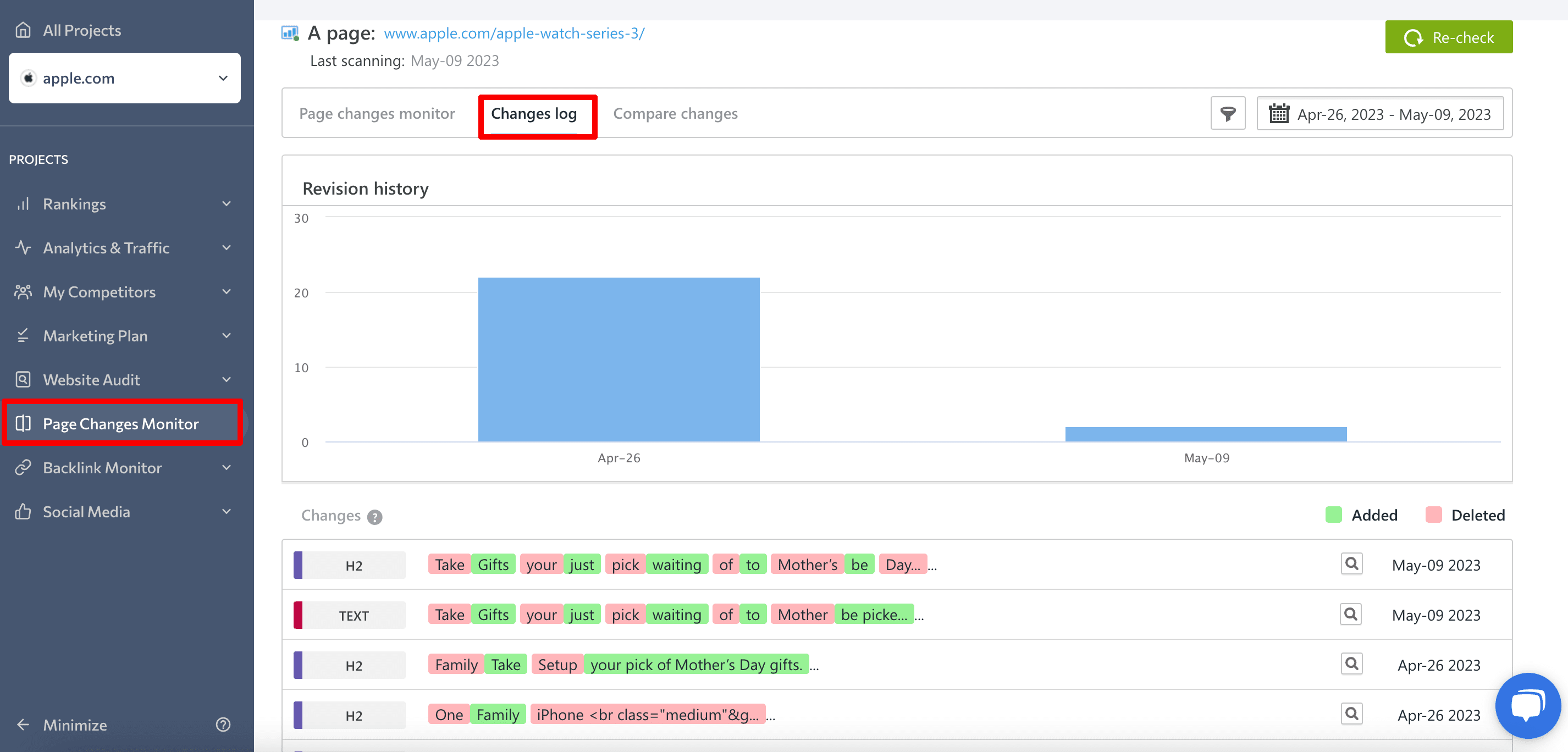
Local Marketing
37. Manage your NAP across business catalogs
If you want to help potential customers find your local business, pay special attention to local directories. These provide the most important information about your company.
SE Ranking’s Local Marketing tool can help you find out which local directories list your business and which ones don’t. You can also identify and correct NAP errors in listings directly from SE Ranking. This includes making edits to the name, address, phone, URL, working hours, business category, and description.

38. Keep an eye on user reviews
You probably know that reviews play a crucial role in business development. By monitoring user reviews, businesses can gain valuable insights to improve their products, services and overall customer experience.
Tracking company reviews from different sources manually can be inconvenient and time-consuming. SE Ranking can automate this process for you.
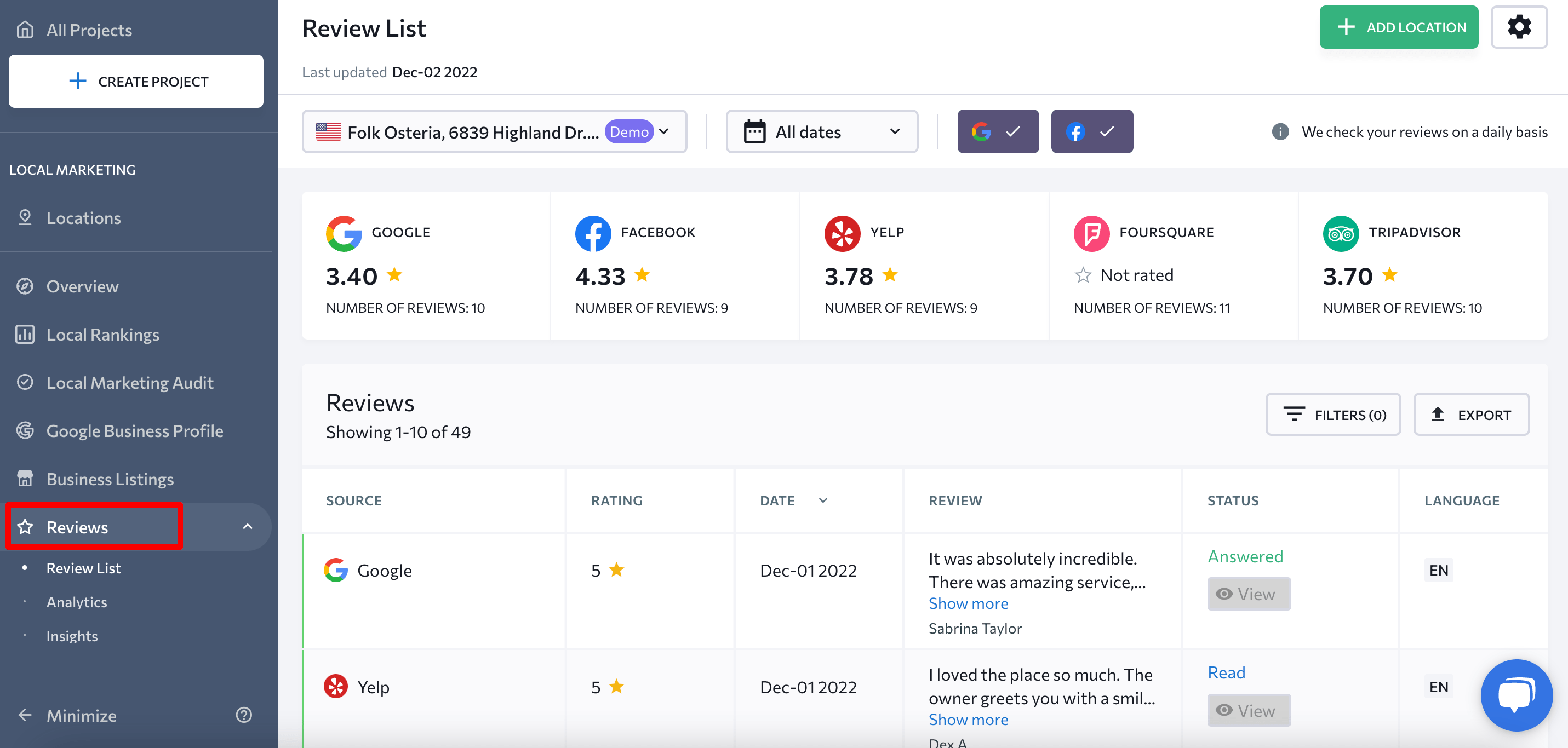
The Reviews section in the Local Marketing tool provides valuable insights into a business’s online reputation by tracking and analyzing user reviews from popular platforms like Google, Facebook, Yelp, Foursquare, and Tripadvisor. In this section, you can see ratings, and review details, including the date, author and text. You can also directly respond to customer reviews on Google and Facebook through the platform.
No only that, SE Ranking incorporates an AI-powered review semantic analysis feature that highlights the most commonly used words and phrases.
39. Track local rankings
If you’re running a local business, then chances are you know how important it is to track your local rankings. SE Ranking’s Local Marketing tool makes this task easy. It allows you to keep track of how your business locations rank on Google Maps.
On the Local Rankings dashboard, you’ll find several charts displaying metrics like the average position per keyword, rankings distribution, overall average position, and average position per tracking point. This data will provide you with a comprehensive overview of your business’s performance in search results. Below, you’ll see a detailed table displaying the positions of your keywords.
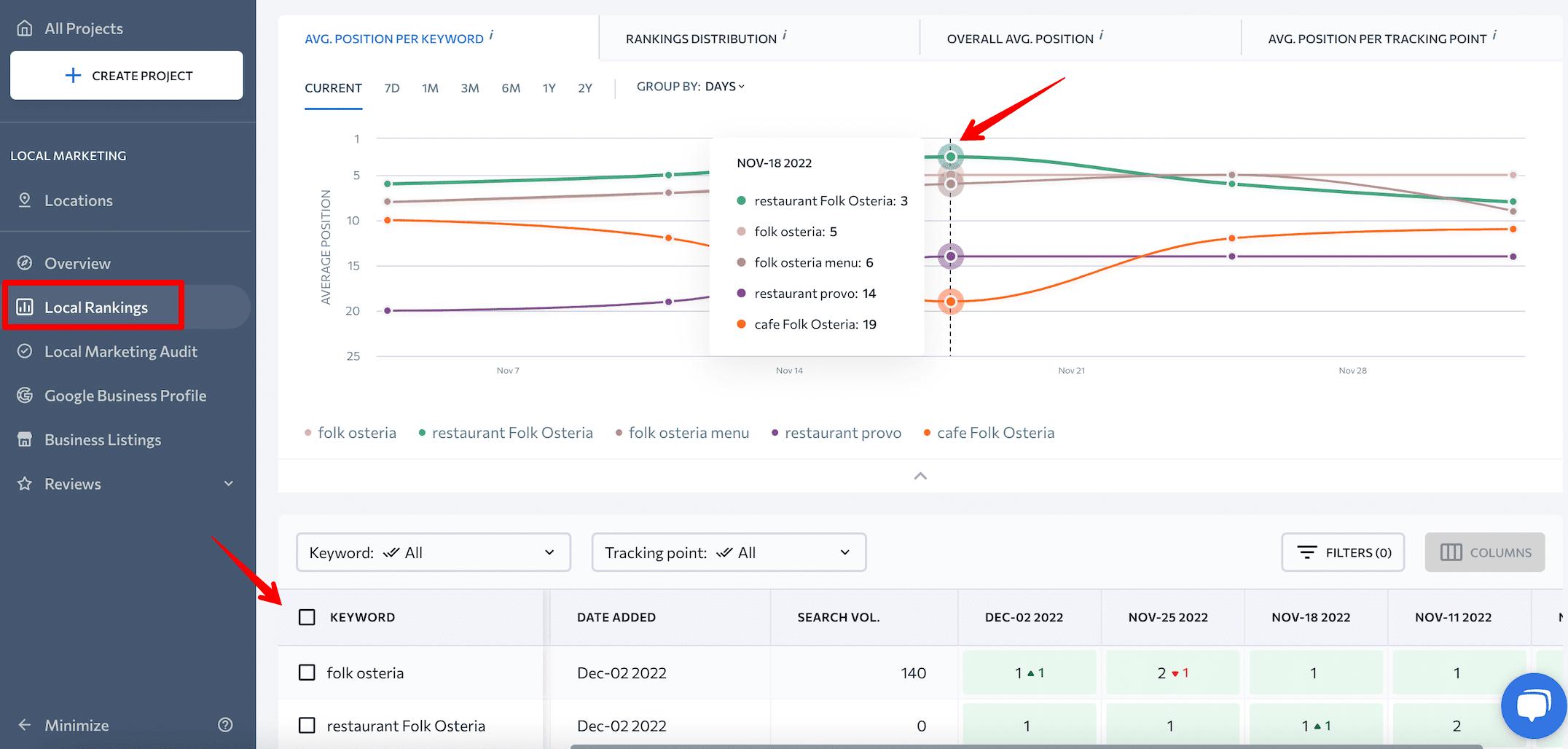
Reporting & White label
40. Create a progress report
Clear, structured reports help understand and evaluate the work of SEO specialists. While some clients are only interested in seeing SERP rankings, others might demand you show them a detailed analysis of every single optimization aspect.
With SE Ranking’s Report Builder, you are at liberty to create the exact kind of report you need. Add your own cover page, table of contents, edit the content, and leave notes. Plus, you can include such sections as Rankings, Analytics & Traffic, My Competitors, Social Media, Website Audit, Backlink Checker, Backlink Monitor, Marketing Plan, full Account Report, Competitive Research and Keyword Research.
Moreover, each report section can be added or removed depending on what you need, and, of course, the report can then be downloaded in PDF, HTML, XLS file formats.
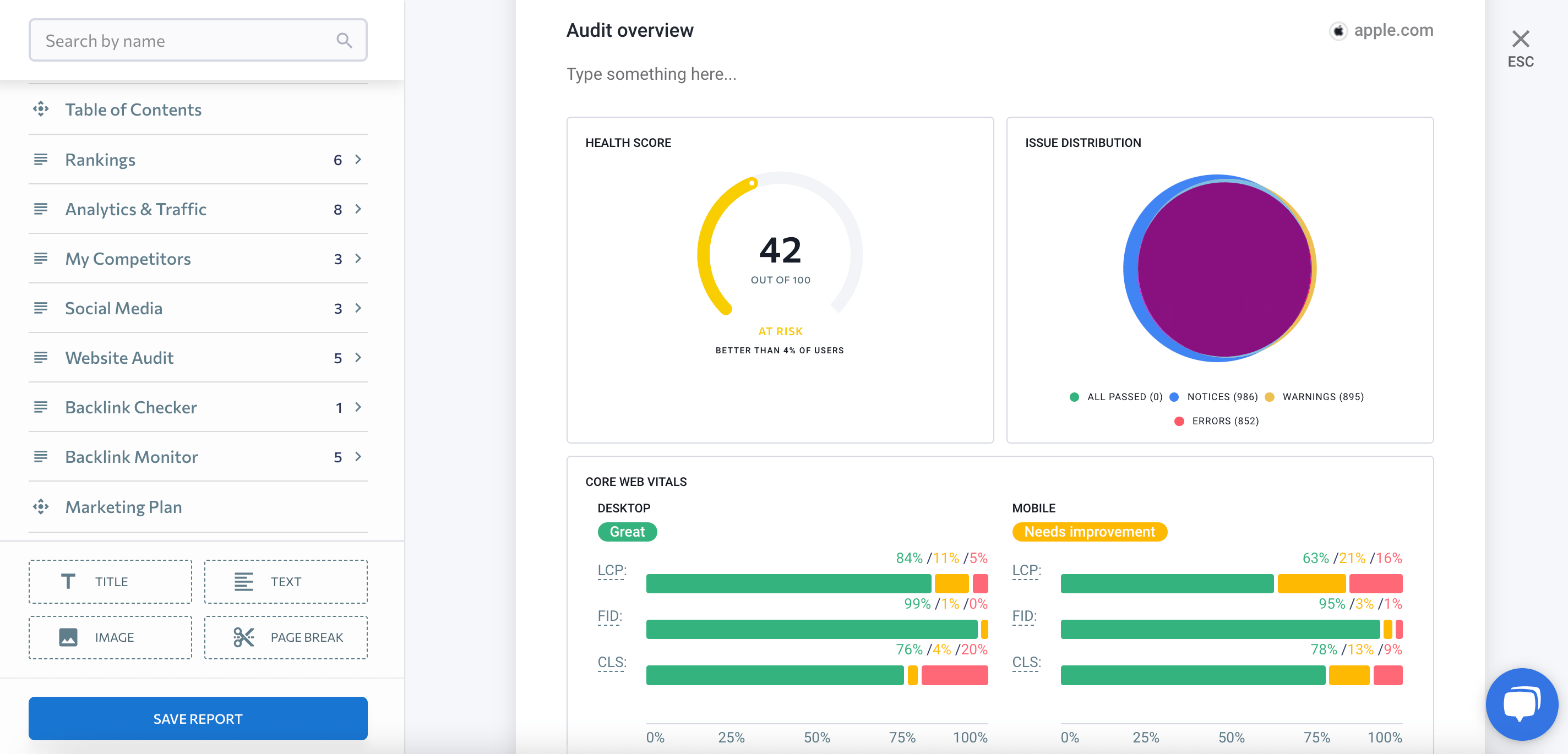
41. Automatically share reports via email
Website progress reports may be of interest not only to your clients, but to your marketing team, colleagues, and senior management as well. But creating and sending them out manually seems like an awful waste of time. For situations like this, every SEO expert needs to be able to send out reports automatically to help stakeholders stay on the same page.
Under the Scheduled tab of SE Ranking’s Report Builder, you can automatically send out regular reports to different emails.
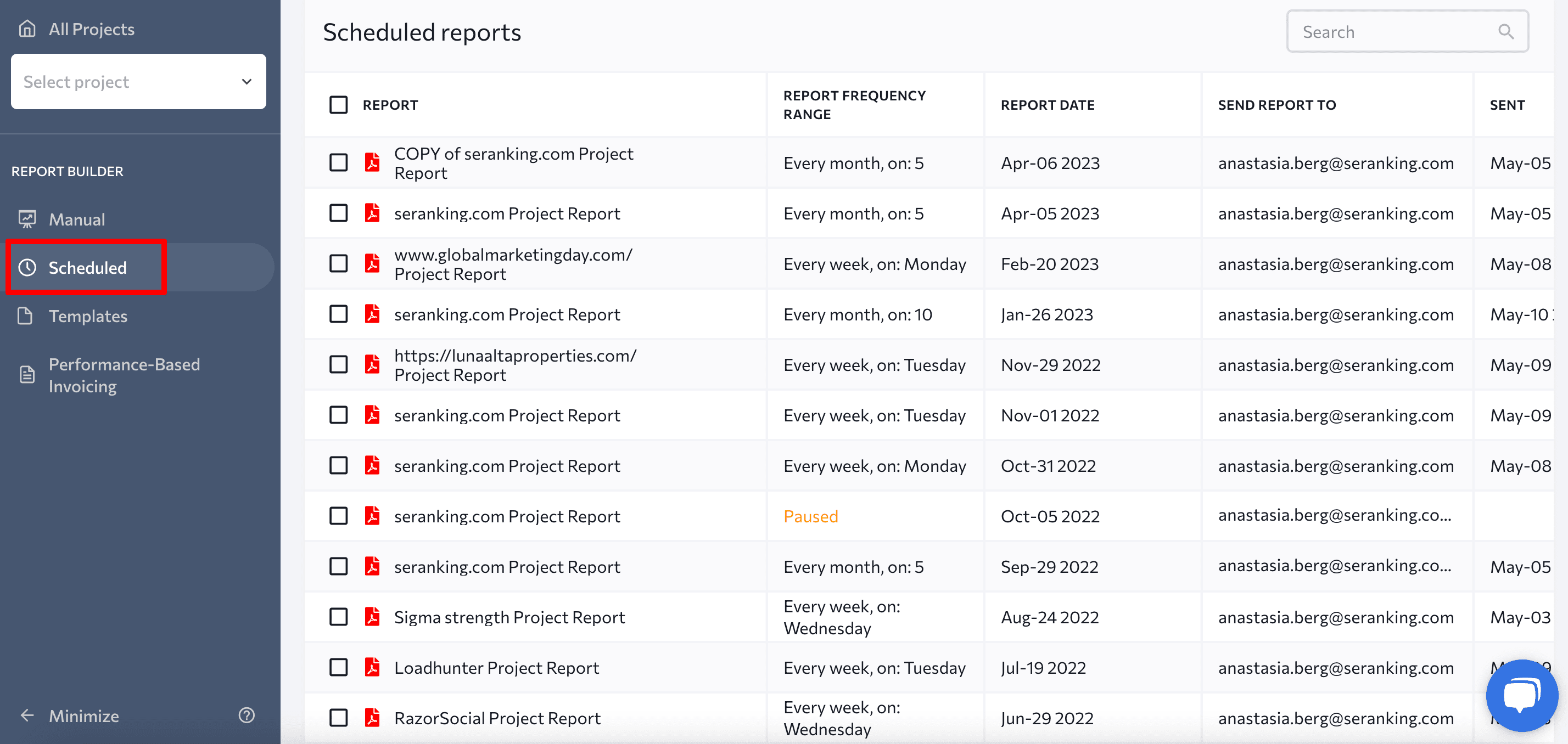
42. Share real-time data via guest links
The guest link is another useful feature for anyone who optimizes websites for clients. By using the Guest link feature, you can easily share the project’s data with your clients, teammates, or management without requiring them to log into the system. Simply click the Guest link button in the appropriate tool and copy the link to share it with others.
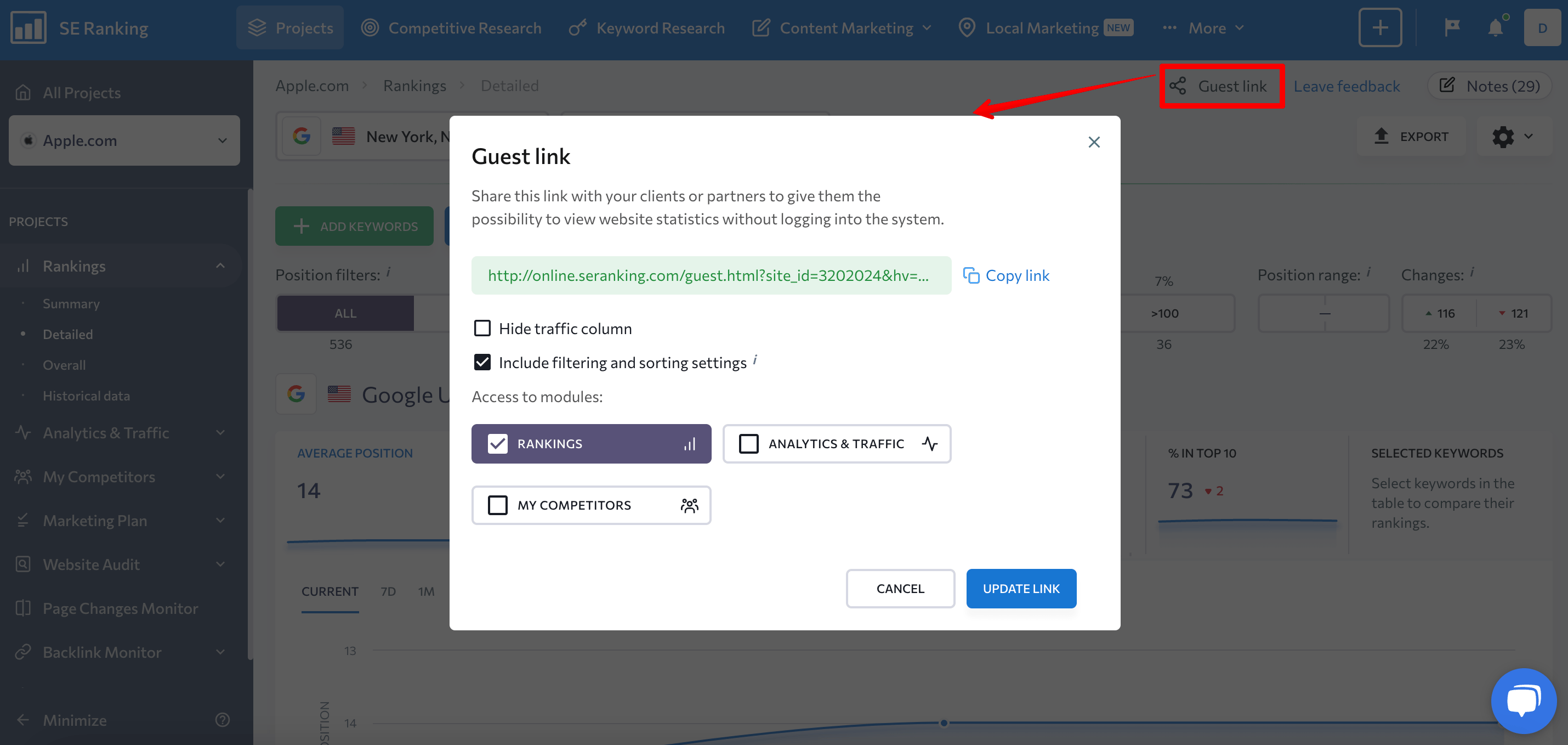
This feature is available for multiple tools, including Keyword Rank Tracker, Local Marketing tool, Content Editor, On-Page SEO Checker, SERP Analyzer, and more.
43. White label the platform
SE Ranking’s White label feature is great for anyone who wants to personalize the platform and present the tool as their own. This can help you strengthen customer loyalty and deliver customer reports to clients using your own brand name.
In the White Label section, you can personalize the interface by adding your company’s name and logo. You can also choose your corporation’s color scheme and configure your own SMTP server. This allows you to create your own SEO solution powered by SE Ranking.
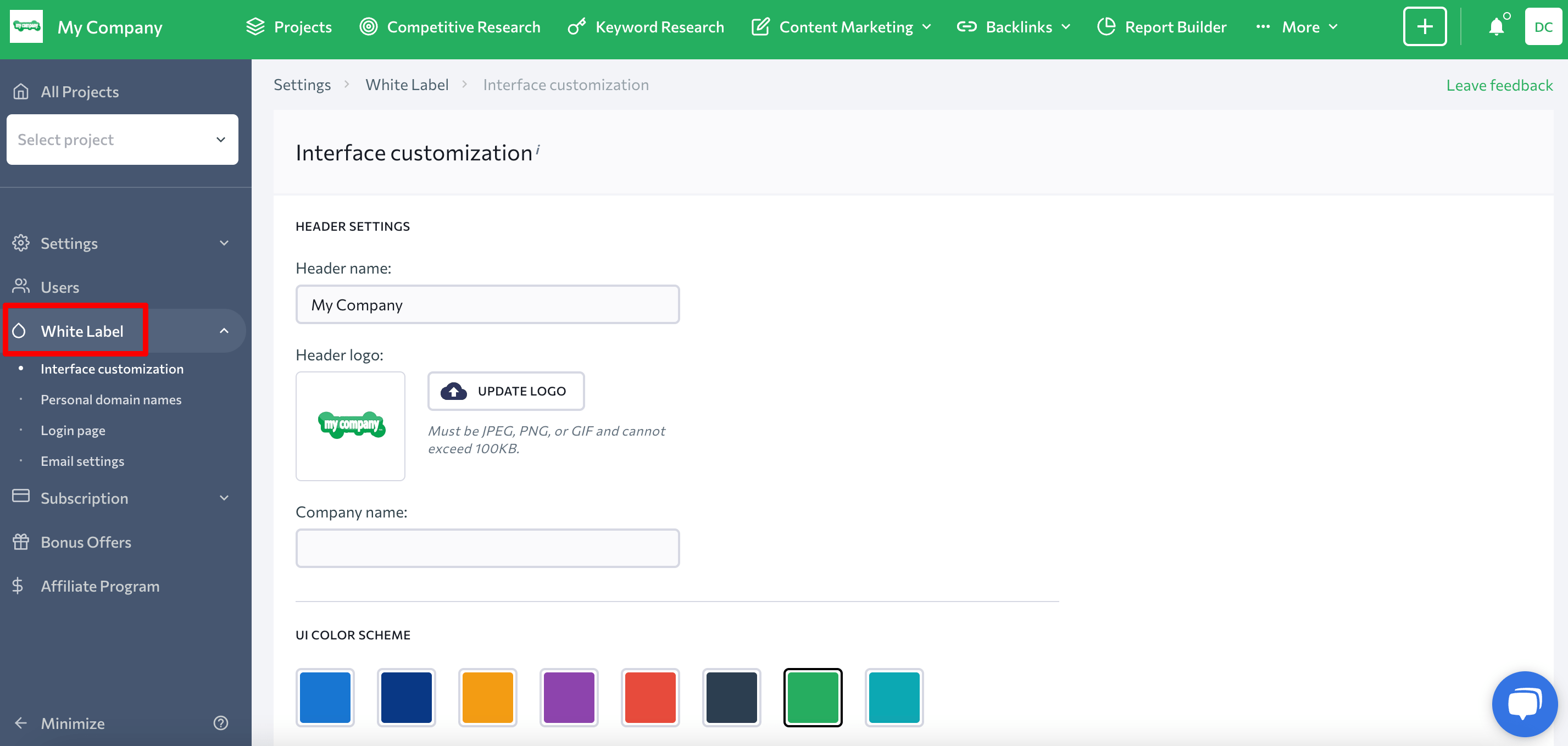
BONUS: Manage your website on the go with our mobile app
If you need to step away from your office desk, you always have SE Ranking’s essential tools at hand. The SE Ranking mobile app for iOS and Android devices will keep you posted on your website’s SEO success, current rankings and ranking history, on-site audit reports, marketing plan progress, list of business directories, etc.
The best part of it all—SE Ranking customers can access the mobile app for free. Once you download the app from the App Store or Google Play and sign in using your credentials, your projects will be just a tap away.
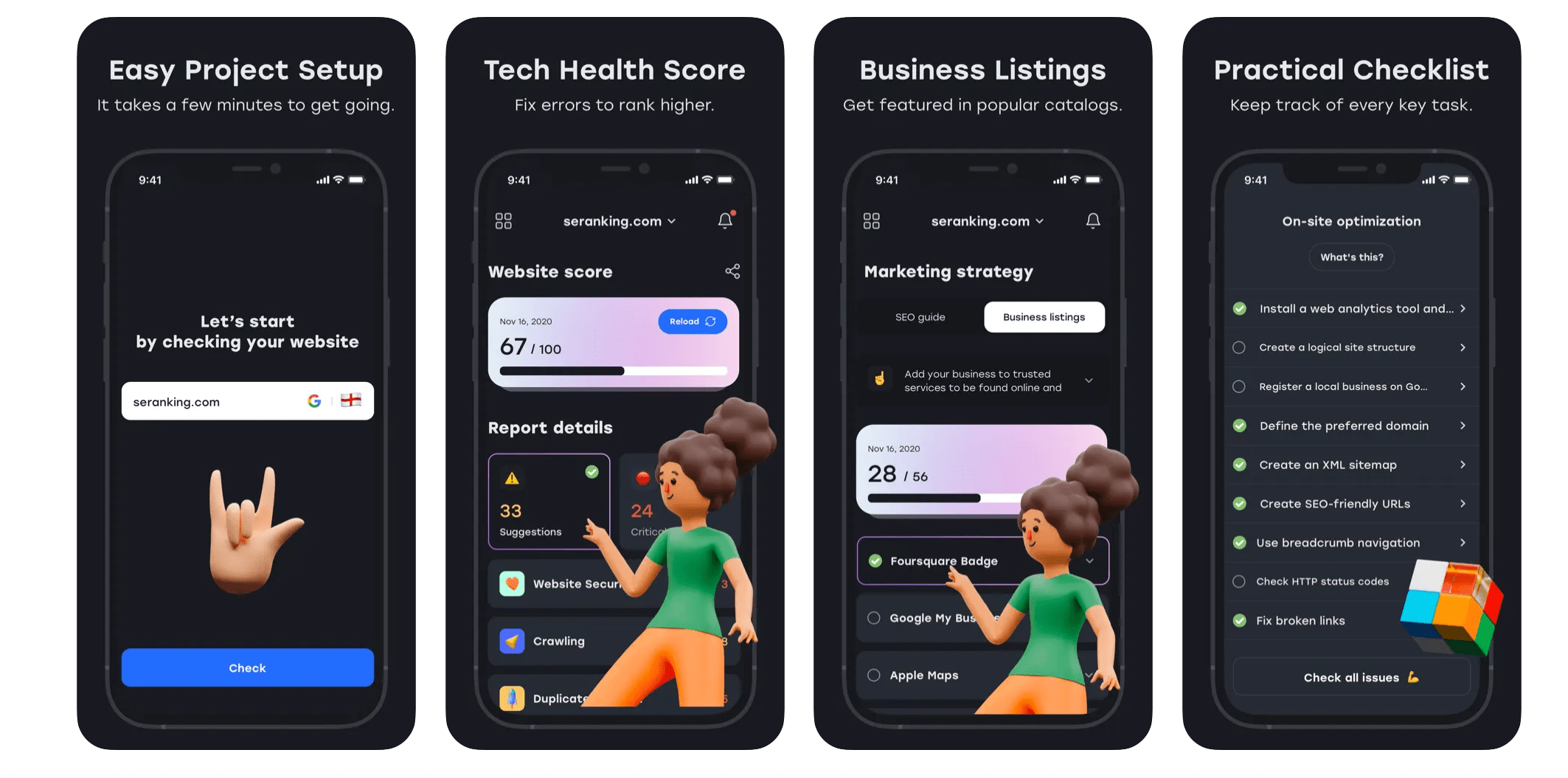
Seems like a long list, but completing these tasks from a single platform will remove all the extra hassle, freeing you up to focus on your business.
We are always busy working on improving our platform and providing our users with top SEO tools and features, which is why the list of tasks you can complete in SE Ranking is bound to continue expanding.
Keep an eye on our updates to be among the first to know when we release something new to facilitate your SEO. Here’s to higher search rankings!

